


How to access bonus editorial features
















David’s interest in photography started almost 40 years ago, when he bought an Olympus SLR camera to go with him to Switzerland for the summer. His interest has waxed and waned since then but got a real boost when he bought a Fujifilm X-T30 a couple of years ago. It has solidified photography as a passion.
For day-to-day opportunities, David usually relies on his smartphone, but when he’s feeling artistic, he fires up the Fuji and goes for a wander, whether that’s in his hometown of Winnipeg or while on vacation in Mexico, Italy or Singapore. He does all his work inside the camera, not relying on later editing for tweaks. “I’d have to learn how to use Photoshop and I’m not willing to do that,” he says.
Instead, he changes the settings in the device, which gives him an element of surprise when viewing the photos later. Of course, he always uses the standard settings as well.
In his non-photographer life, David is a patent agent and has a PhD in physics. He is married to Shauna Dobbie, editor of Canada’s Local Gardener.

Follow us online https://www.localgardener.net
Facebook: @CanadasLocalGardener
Twitter: @CanadaGardener
Instagram: @local_gardener
Published by Pegasus Publications Inc.
President/Publisher
dorothy dobbie dorothy@pegasuspublications.net
Design Cottonwood Publishing services

Editor shauna dobbie shauna@pegasuspublications.net
Art Direction & Layout Karl Thomsen karl@pegasuspublications.net
General Manager Ian Leatt ian.leatt@pegasuspublications.net
Contributors
dorothy dobbie, shauna dobbie, adrienne Herron, david Johnson.
Editorial Advisory Board
Greg auton, John Barrett, Todd Boland, darryl Cheng, Ben Cullen, Mario d oiron, Michel Gauthier, Jan Pedersen, stephanie rose, Michael rosen, aldona s atterthwaite, and Trudy Watt.
Advertising Sales
1.888.680.2008
Subscriptions
Write, email or call Canada’s Local Gardener, 138 swan Lake Bay, Winnipeg, MB r 3T 4T8



Phone (204) 940-2700 Fax (204) 940-2727
Toll Free 1 (888) 680-2008 subscribe@localgardener.net
one year (four issues): $35.85
Two years (eight issues): $71.70
Three years (twelve issues): $107.55
single copy: $10.95; Beautiful Gardens: $14.95 150 years of Gardening in Canada copy: $12.95 Plus applicable taxes.
return undeliverable Canadian addresses to: Circulation department Pegasus Publications Inc. 138 swan Lake Bay, Winnipeg, MB r 3T 4T8
Canadian Publications mail product sales agreement #40027604
Issn 2563-6391
Canada’s LoC aL Gardener is published four times annually by Pegasus Publications Inc. It is regularly available to purchase at newsstands and retail locations throughout Canada or by subscription. Visa, MasterCard and american express accepted. Publisher buys all editorial rights and reserves the right to republish any material purchased. reproduction in whole or in part is prohibited without permission in writing from the publisher.
Copyright Pegasus Publications Inc.



Nothing could be easier than growing beans. After all, didn’t so many of us bring home a bean we planted in a cup in Grade 1 for our moms to plant in the garden? I did. We lived in an apartment. I brought it to my grandma and we planted it, but it died before long.
Beans don’t like to be transplanted. Planting directly into the ground is just one of the things you must do to get the most out of your beans.
When to plant. Beans are warm-season crops and are typically planted after the last frost date in your area. The soil temperature should be around 15 Celsius for optimal germination. Planting too early in cool soil may cause the seeds to rot.
Where to plant. Beans thrive in full sun, so choose a location in your garden that receives at least six to eight hours of direct sunlight per day. Ensure the soil is well-drained and rich in organic matter.
Crop rotation. Plant beans in a different spot from year to year. It prevents overwintering diseases and gives other areas of your garden the benefit of the nitrogen providing roots when the plant dies.
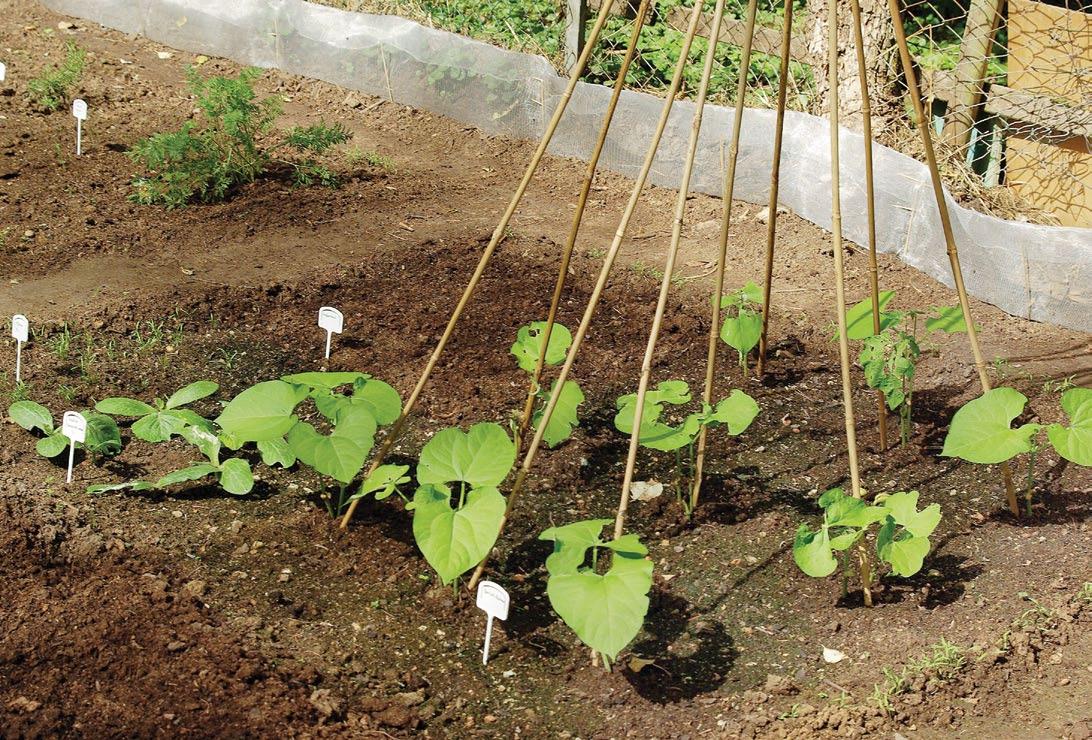
Soil preparation. This depends on how you tend your garden. If you have an established bed that is mulched, in the spring you only need to move some
mulch aside and plant seeds. If you are a cultivator, loosen the soil with a garden fork or tiller. Remove any weeds and incorporate organic matter, such as compost or well-rotted manure, to improve soil fertility and moisture retention.
Planting seeds. Dig small trenches about an inch deep and space the seeds according to the bean variety you're planting. Bush beans can be planted 2 to 4 inches apart in rows, while pole beans need more space and should be planted in rows with a distance of 4 to 6 feet between them. Place the seeds 1 inch deep, cover them with soil, and water gently.
Watering. Beans need consistent moisture throughout their growing season. Water them regularly, aiming to keep the soil evenly moist but not waterlogged. Avoid overhead watering, if possible, to prevent diseases. A soaker hose is the best way to get water to the roots.
Support. If you're growing pole beans or runner beans, provide them with support structures like trellises, stakes, or fences. This helps the plants climb and keeps the beans off the ground, reducing the risk of pests and diseases. Do this ahead of planting or very soon after. It reminds you where the beans are before they start to show, and it prevents disturbing the roots.
Weed control. Keep the bean beds free of weeds, as they compete for nutrients and water. Mulch between the rows and regularly remove any weeds that appear, taking care not to disturb the shallow root system of the bean plants. Pull weeds rather than hoeing because beans have shallow roots.

Fertilization. Beans are generally light feeders and do not require heavy fertilization. However, if your soil is poor, you can apply fertilizer or compost before planting. Excessive nitrogen can result in lush foliage but fewer bean pods. In general, you want the first NPK number to be lower than the other two – something like 5-10-10.
Temperature. If it goes above 30 Celsius for a sustained period, your bush beans will benefit from the shade of a row cover. If you can’t cover them, the blossoms may drop. For pole beans, you’ll just have to accept it. If you live in an area where high temperatures are expected, look for varieties that can handle the heat.
Insects. Beans can be attacked by aphids and spider mites, for which you simply need to wait to see if a solution appears (ladybugs). If not, spray them off. You probably won’t need to resort to spraying with anything other than water. They can also be attacked by Japanese beetles, cucumber beetles and Mexican bean beetles. Handpick and destroy any that you see. For severe infestations, try a pyrethrin-based product from Safers or Doktor Doom.
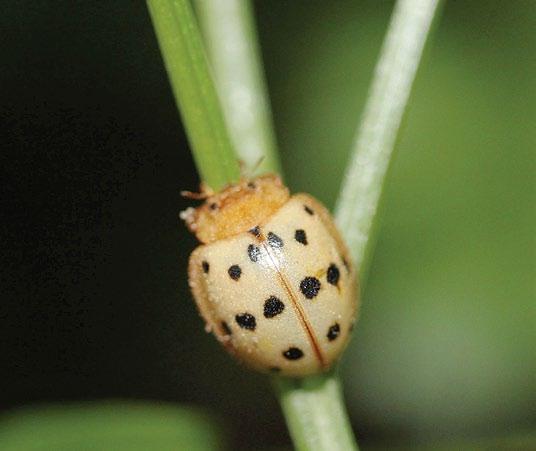

Bacterial and fungal diseases. Plant disease resistant varieties of any common bacteria or fungus in your area. If you see a small infection, carefully cut out the part with clean secateurs and throw it immediately into a bag for the garbage. Monitor the plant to see if you got it all. For larger infections, try a sulfur spray, following the directions on the bottle.
Harvesting. The harvesting time depends on the type of bean you're growing and what you plan to use it
for. Generally, there are three harvest points for beans. Beans when they are harvested young go by several names, including green beans, string beans, French beans, haricots or snap beans. You eat them fresh, pods and all. Green beans don’t have to be green; they can be purple, yellow or multi-coloured. The seeds inside are small. Snap the pods off the plant. They could be ready as soon as 50 days after planting the seeds. If you can see the beans inside the pods bulging, you’ve waited too long.
Shelling beans are the kind you eat when the beans are fully developed but the pods haven’t dried. The beans will be fat inside the pods and the pods will be tough. These can be ready as soon as 66 days after planting. You eat the beans, not the pods.
Dried beans are for storage and eating later. In the warmest places, you wait until the seeds rattle around inside the pods. In more northerly places, you can harvest the pods when they are yellow and hang them in a warm dry place after the snow has fallen. They are ready when you can hear them rattle. These beans take 90 days or more to reach harvest. P
If you’re tired of growing the same old beans, try the following for a little zip.
‘Orca’ look like little black and white cows. Good for shelling or drying. The white turns to tan and the black lightens to brown when cooked.

‘Christmas’ is a type of lima bean. They are striated in red and white. Good for shelling or drying.

‘Hidatsa Shield’ is an heirloom variety that was cultivated by the Indigenous Hidatsa people in North Dakota. They are mostly white, and the bottom third are the colour of café au lait with splotches of red. They are good for eating fresh, shelled or dried.
‘Jacob’s Cattle’ look like brown and white spotted cows. The white turns tan when cooked. Good for drying.
‘Canadian Wild Goose’ are creamcoloured with grey-green freckles and a splotch of white at the bottom. Good for dried.
‘Tiger Eye’ are deep tan with swirls of maroon. Good for shelling or drying.
‘Zenith’ have a single splotchy brown eye on a white bean. Good for dried.

‘Rattlesnake’ come in pods that are green striped with purple. You can eat them at any time, either as green beans, shelled or dried. The beans inside are white but turn brown over time. The pods lose their colour when cooked.
‘Dragon Langerie’ are almost-white pods streaked with purple, which fades when cooked. The beans inside are purple. Good for snap, shelled or dried.
‘Painted Pony’ are longer than others, though small, brown on one side and white on the other, with spots in between. Can be used for snap, shelled or dried. The pods are stringless when young.



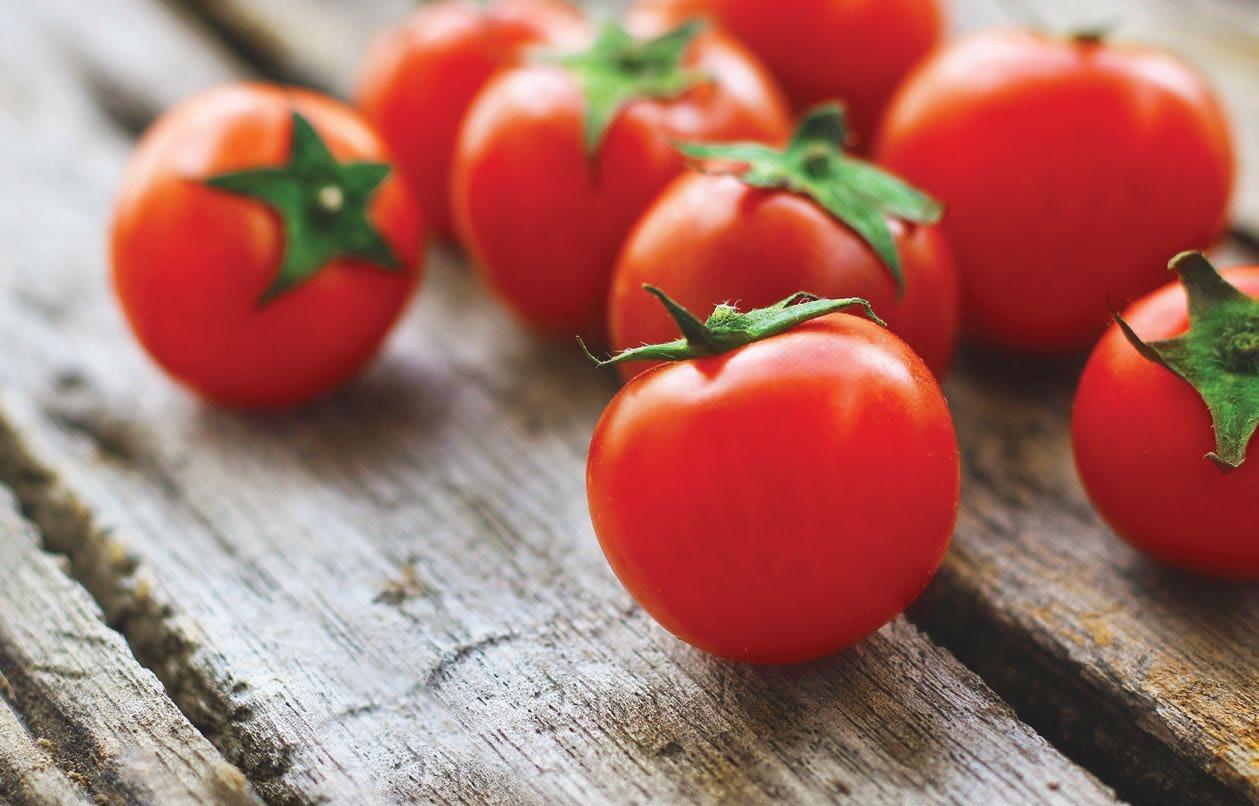

 story by dorothy dobbie
story by dorothy dobbie
Under the sweet-peas I stood And drew deep breaths, they smelt so good. Then, with strange, enchanted eyes, I saw them change to butterflies. Higher than the skylark sings I saw their fluttering crimson wings Leave their garden-trellis bare And fly into the upper air.
– Alfred Noyce (1880-1958)Sweet pea, Lathyrus odorata, the fragrant pea, lives up to her name with a lovely scent of honey and orange blossoms. Moreover, she is beautiful. Shaped a bit like a butterfly, sweet pea blossoms come in all the muted shades of pink, purple, and white, from bright white to creamy white. They grow on longish stems, 6 to 8 inches, on a climbing plant that can reach 8 feet into the sky when happy.
Sweet peas are native to southern Italy and Sicily, finding their way to Britain in 1699, a memorable day (see sidebar), and then to North America in the 1800s. Today, there are many cultivars, increasing the number of varieties and colour permutations from deep purple and red to red and white striped. But still a favourite is one of the oldest, Cupani’s original, a lovely mauve, highly scented flower with dark purple edges.
The seeds are small but pea-like and require scarification either by nicking or soaking overnight. Poke a pencil into the soil and add one or two seeds to a hole 2 inches deep if starting outside. Sweet peas need rich soil so plant them in well-composted medium or add bone meal to the planting area. Soil should be moist but not wet. Overwatering and over fertilizing will cause the foliage to turn yellow. Give sweet peas six to eight hours of sunlight.

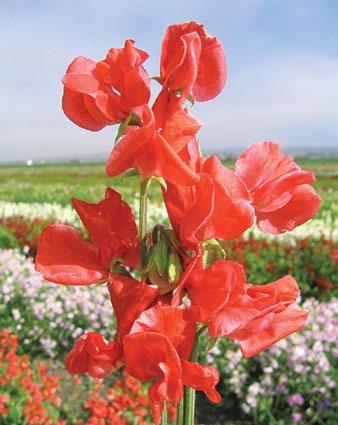
They wilt and die back when the weather becomes too warm, so expect their best performance in May and June. They bloom six to eight weeks and the more you cut them the more they will flower. Bud drop indicates that they are too warm.
Start them early – they will germinate at 13 to 18 Celsius and don’t mind a late, light frost. Some people start them indoors, but they can go
straight into a well-prepared garden. It is worth trying for a second crop in September.
These are climbing plants with tendrils very similar to peas. Give them something to climb on: a plastic netting or a trellis that they can get those fine tendrils around. Sweet pea tendrils will favour a support of small-
er dimensions. A trellis of bent willow twigs makes a rustic base.
The enemies of sweet peas are aphids, slugs, and snails, but otherwise sweet peas are generally trouble free, although pea moth could be a problem in late June and July in more moderate parts of the country.
Unlike their cousins, the edible pea,
sweet peas are poisonous and ingesting too much of them can cause a disease called lathyrism leading to fatigue, shallow breathing, convulsions and finally paralysis of the lower limbs. It is incurable. Don’t let that deter you, though. Many of the ornamentals we plant in our gardens are poisonous if eaten. P
The first mention of sweet peas in England can be found in the writings of the Franciscan monk, Francis Cupani, who sent seeds of the wild sweet pea to England in 1699. These original seeds had a strong fragrance and deep magenta flowers. Cupani's sweet pea became popular among garden enthusiasts, and it laid the foundation for the cultivation and hybridization of sweet peas in England. In the 19th century, the sweet pea gained significant attention and popularity thanks to the efforts of a Scottish nurseryman named Henry Eckford. Eckford began breeding and hybridizing sweet peas in the late 1800s, aiming to improve the flower's size, colour range, and scent. His work resulted in the development of numerous new
varieties and the establishment of sweet peas as a beloved garden flower.
Eckford's sweet peas gained recognition and won numerous awards at horticultural shows, attracting the attention of gardeners and breeders across England. The vibrant colors, intricate patterns, and delightful fragrance of the sweet pea blossoms captured the hearts of many.
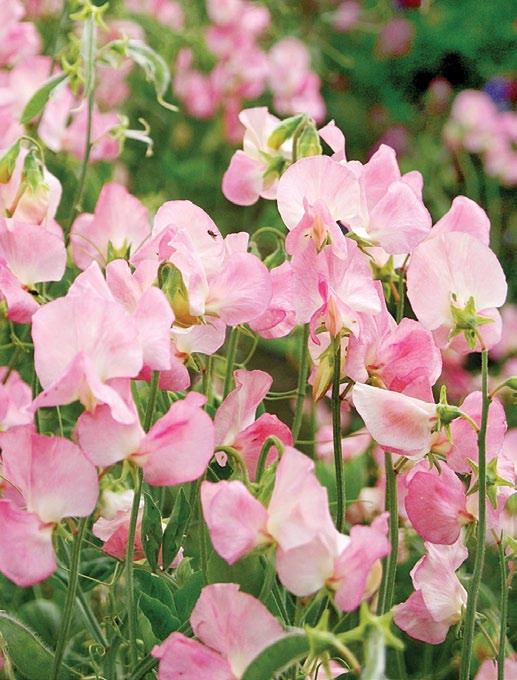
During the early 20th century, sweet pea cultivation became increasingly popular, and a dedicated group of enthusiasts formed the National Sweet Pea Society in 1901 to promote the flower. They organized exhibitions, competitions, and encouraged the development of new varieties through breeding programs.
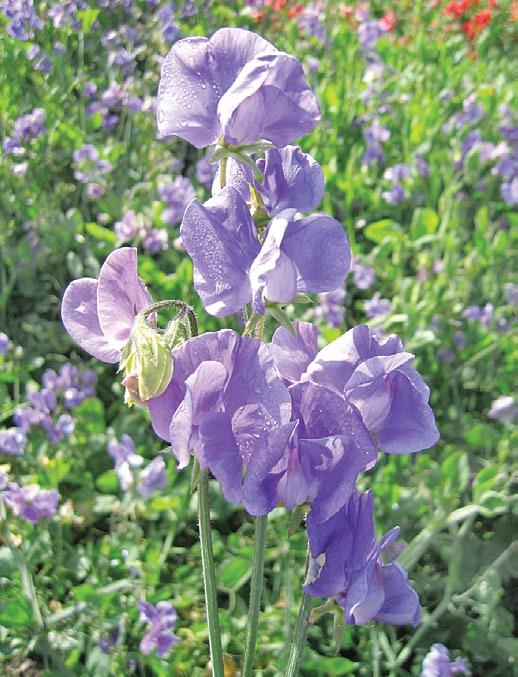
Sweet peas continued to be bred and
hybridized by enthusiasts and horticulturalists throughout the 20th century, leading to the creation of countless new cultivars. These efforts expanded the range of colors, sizes, and fragrances available, making sweet peas even more popular in England and beyond.
Today, the sweet pea remains a cherished flower in English gardens. It is widely cultivated and appreciated for its stunning blooms and delightful fragrance. Sweet peas are often grown as ornamental plants, and their flowers are used in floral arrangements, perfumes, and potpourri. The legacy of Francis Cupani and Henry Eckford continues to thrive as sweet pea enthusiasts continue to develop new varieties and keep this beautiful flower in the hearts of gardeners everywhere.
Lathyrism is a neurological disorder caused by the consumption of certain legumes, particularly those of the Lathyrus, such as L. sativus, commonly know as grass pea, and L. odoratum, the sweet pea.
Grass pea is a hardy legume that has been cultivated for centuries, especially in areas with poor soil conditions or during times of food scarcity. The seeds of the grass pea are rich in protein and can serve as a valuable food source. However, they also contain a toxic amino acid known as BOAA.
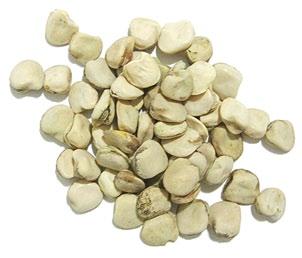

When consumed in large quantities over an extended period, BOAA can lead to the development of lathyrism. The exact mechanism by which BOAA causes lathyrism is not fully understood, but it is believed to have neurotoxic effects on the central nervous system.
Lathyrism primarily affects the spinal cord, leading to a range of symptoms. The most common symptom is a progressive and irreversible paralysis of the lower limbs, which is often accompanied by muscle weakness and wasting. Other symptoms may include spasticity, tremors, stiffness, and difficulty in walking.
Lathyrism is more prevalent in
areas where grass pea is a dietary staple and consumption is high. It has been historically associated with periods of famine and drought when grass pea was relied upon as a survival food. Lathyrism outbreaks have occurred in various parts of the world, including India, Bangladesh, Ethiopia, and parts of Europe.

Emerald Ash Borers are a threat!
Invasive species threaten Manitoba’s trees. The emerald ash borer and other insects live in firewood. When firewood is moved between locations, so are the insects.
One log can kill a million trees. Learn more at: Manitoba.ca/stopthespread
Lisianthus (Eustoma) will make your heart sing with its roselike, funnel-shaped flowers of every colour and combination of bicolour. This is one of the loveliest natives of North America growing in Zone 8 plus. Many people overlook this pretty flower at the local garden centre because it typically does not bloom until later in the summer, past the garden shopping frenzy of a Canadian springtime.
Lisianthus is also difficult to grow from seed, requiring precise conditions to succeed. The seeds are very tiny, dust-like, and it takes many months for a plant to mature – they need to be planted indoors 10 to 12 weeks before the last frost in Canada. They are planted on the surface of damp soil, not buried, so misting rather than watering will help them to germinate. Grow under a dome or some transparent cover and give them 16 hours of light a day. Temperature needs to be carefully controlled between 21 and 24 Celsius during germination and for the first two weeks. They can handle a slightly cooler temperature, as low as 18 Celsius as they grow, but do not let the temperature exceed 24 Celsius to avoid sending them into dormancy
as they develop. Four months later, you can begin to introduce them, gradually, to the great outdoors –being sure that there is no longer any danger of frost.
Also called prairie gentian, Eustoma russellianum, was not half as pretty before 1930 when a group of Japanese hybridizers groomed her into the lovely creature she is today.
The flowers can be as much as 2 inches across on stems from 1 to 3 feet tall. There are even some dwarf varieties growing to only 8 inches. They like bright morning sun and heat and they’re drought tolerant. If you are growing them in a container, be careful not to overwater. In the wild they like about an inch of rainfall a week. They prefer rich soil and will reward with more bloom if you fertilize with a high potassium fertilizer.
Some readers, having seen that the
plant is a perennial (some varieties are biennial) in their native south, are bound to ask if they can be overwintered indoors. It is possible. Lack of light is the greatest enemy of this endeavour. If you can get rosemary through our cold months, then maybe you have a chance.
Lisianthus is a much-in-demand cut flower for weddings and other events as they are particularly long lasting in a vase. They will stay perky for up to two weeks – even up to four weeks under the right conditions: change the water every couple of days, adding ⅛ cup of sugar to a quart of water and a drop of bleach to keep bacteria under control, and cut the stems as you change the water.
This is one flower that thrives on being deadheaded, sending up new flowers to replace those you remove.
Lisianthus symbolizes charisma, charm, confidence and appreciation.


If you think oxygen therapy means slowing down, it’s time for a welcome breath of fresh air.

Introducing the Inogen One family of portable oxygen systems. With no need for bulky tanks, each concentrator is designed to keep you active via Inogen’s Intelligent Delivery Technology.® Hours of quiet and consistent oxygen flow on a long-lasting battery charge enabling freedom of movement, whether at home or on the road. Every Inogen One meets FAA requirements for travel ensuring the freedom to be you.

• No heavy oxygen tanks

• Ultra quiet operation
• Lightweight and easy to use
• Safe for car and air travel
• Full range of options and accessories
• FAA approved and clinically validated






Powdery mildew is that white coating that can attack plant leaves, stems and even fruit and finally it can weaken and kill the plant in extreme cases. It is a flat coating that can occur in spots or it can cover the whole leaf or stem. It is caused by various fungi.
It may seem counterintuitive, but powdery mildew thrives in warm, dry weather when the spores can travel freely on the wind. It does even better when combined with cool and humid nights. When the whole day is rainy and cool, spores can’t germinate because they need just the right amount of sunlight.
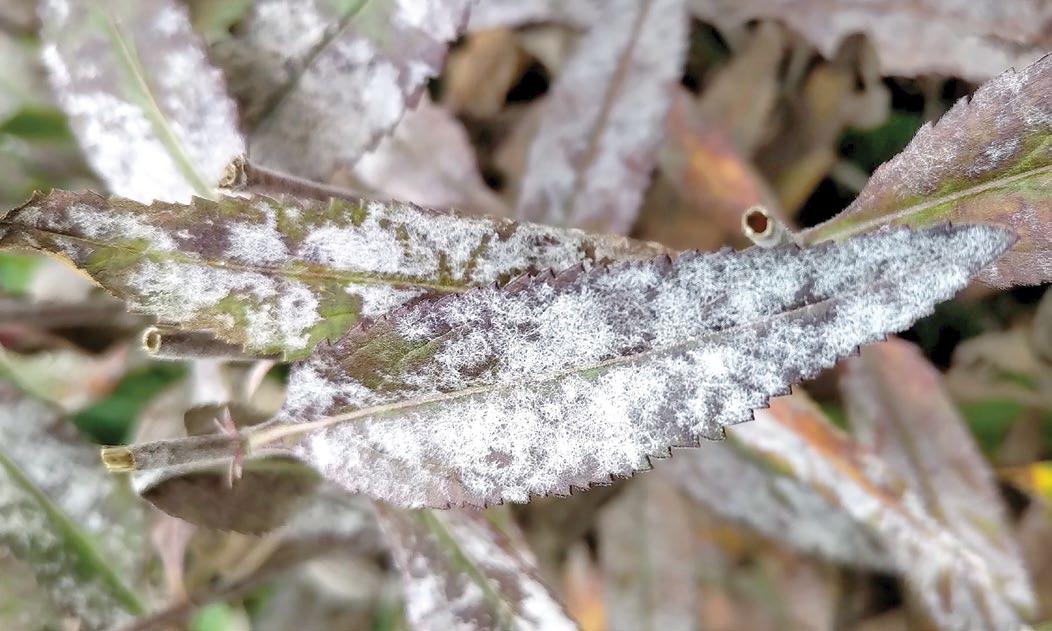
In areas with very cold winters, spores will be killed unless protected by debris or in the soil, so be sure to clean up infected foliage in fall.
Powdery mildew specializes in certain plants so doesn’t spread to those outside its chosen family. Not that this is much comfort if your squash or tomatoes are suddenly attacked.
The quickest cure in the earliest stages is to remove and care-
fully dispose of any affected leaves or stems. Then diligently treat with a preventative, a number of which are listed here.
What you want, ultimately, is to avoid having powdery mildew attack at all. Look for varieties of plants that are mildew resistant. For example, bee balm is a favourite victim, but the variety ‘Marshall’s Delight’ has been bred to resist powdery mildew and it does so quite successfully.
Be sure there is enough air circulation between plants.
Once the mildew has attacked, you can use the recommended remedies but be sure to cover all of the surfaces including the stems and the under-
sides of leaves. Don’t stop at just one application. Apply every few days to ensure there are no new infections. Preventatives and treatments to try
• Baking soda solution: Mix 1 tablespoon baking soda and ½ teaspoon liquid soap (not detergent) in 1 gallon of water. Spray on all affected areas. Good preventative measure.
• Milk: Mix one part milk to two to three parts water and spray. It works well on zucchini, melons, and cucumbers. Natural compounds in the milk combat the disease and boost the plant’s immune system.
• Powdery mildew fungicide: Use sulfur-containing organic fungicides as both preventive and treatment for existing infections.
• Hydrogen peroxide: Mix one part drugstore hydrogen peroxide (3 percent) to nine parts water to kill spores.

• Trim or prune: Remove and dispose of infected leaves, stems, buds, fruit, or vegetables from the plant. Disinfect pruners and all tools after using on infected plants. P

Flowering houseplants always seem to be a challenge to raise, but the lipstick plant ( Aeschynanthus) is one that is not too difficult and is very rewarding. A vine, this plant originated from Southeast Asia. In the wild, it can grow to 6 feet but in a houseplant container it is likely to get no bigger than 18 inches. It also benefits from pruning in seasons when it is not blooming.
There are a couple of common varieties . A. pulcher has hair-covered, dark maroon calyxes and dark red buds. A. radicans, also known as the red bugle vine, has smooth flowers of a lighter colour.
The leaves of A. pulcher are an attractive dark green, somewhat leathery, and pointed oval. It is the flowers, however, that steal the show – not because they are especially showy but because they are especially interesting. They emerge from the tip of a branch looking like little maroon capsules that soon begin to reveal a scarlet bud extruding from that capsule, (the calyx, really), like lipstick being revealed from a lipstick case, hence the name.
Plant collectors will also want to hear about a sub variety of A. radicans: ‘Rasta’, also known as ‘Twister’. It has, as its name implies, twisted leaves that make it interesting even when not in bloom.
A third variety, seen less often, is A. speciosus, which
has yellow to red flowers, emerging from a light green calyx, and doesn’t really deserve the name lipstick plant. It blooms more readily, however, and has more flowers in each cluster.
Although the lipstick plant is an epiphyte, like some orchids, they are grown domestically in well-draining potting mix. The vine is a moderate drinker but likes humidity. If you can set it on a pebble tray filled with water, that will help to keep the air around it well humidified. Mist it from time to time. Be careful not to overwater as it is prone to root rot. It will also benefit from a regular feed of diluted fertilizer, say every fourth watering in the high growth season, tapering off to every sixth watering, then stop feeding it during the dark months. How much is diluted fertilizer mix? If the product calls for one scoop per gallon every two weeks, cut it back to one-half scoop to gallon every two weeks and so on.
Getting a lipstick plant to bloom requires warmth in both the soil and the air. If the surroundings are too cold, the leaves will turn red. The plant will want 21 to 27 Celsius consistently and that can be a challenge in airconditioned summer homes. If you take it outside for a summer holiday, be sure to keep it out of the sun. It likes bright light and indirect sunlight. Dappled shade would be great.
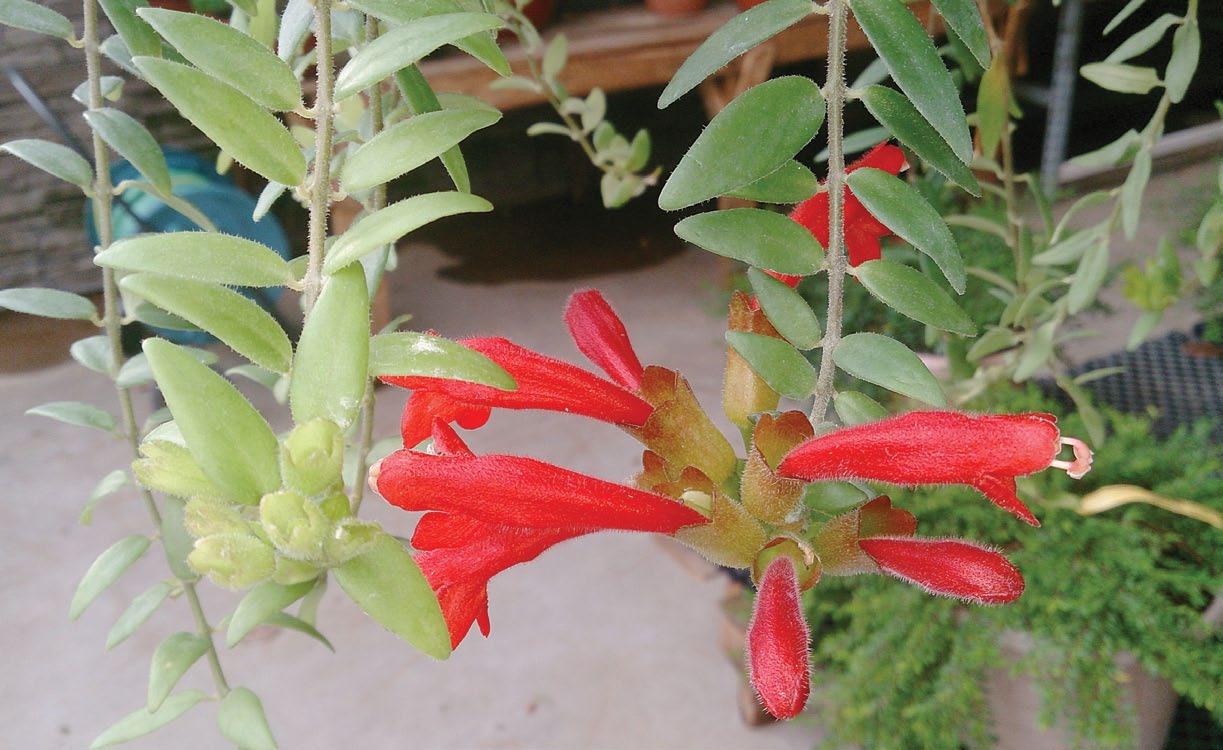
Lipstick plant is not difficult to propagate from cuttings, rooted either in water or with some rooting hormone. Cut soft new growth four to six leaves from the tip. Trim off any stem just below a leaf node. Slice through the node vertically. Treat lightly with rooting compound and insert in a damp mix of vermiculite and perlite. Some people will cover the potted cutting with plastic to keep
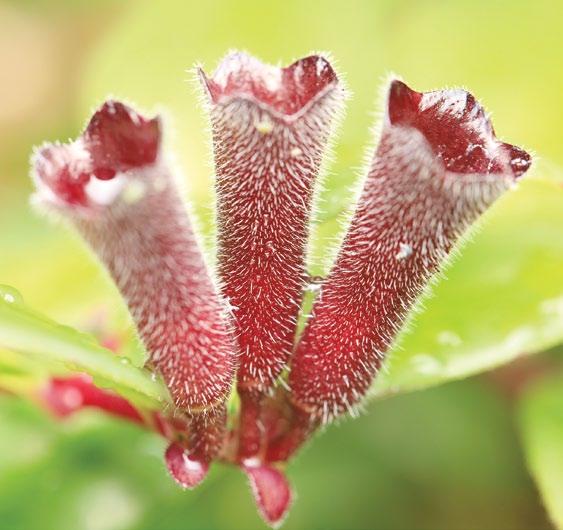
humidity in. It should take root in two to six weeks. Once the roots are well established you can transplant it into a larger container and some well drained potting mix.
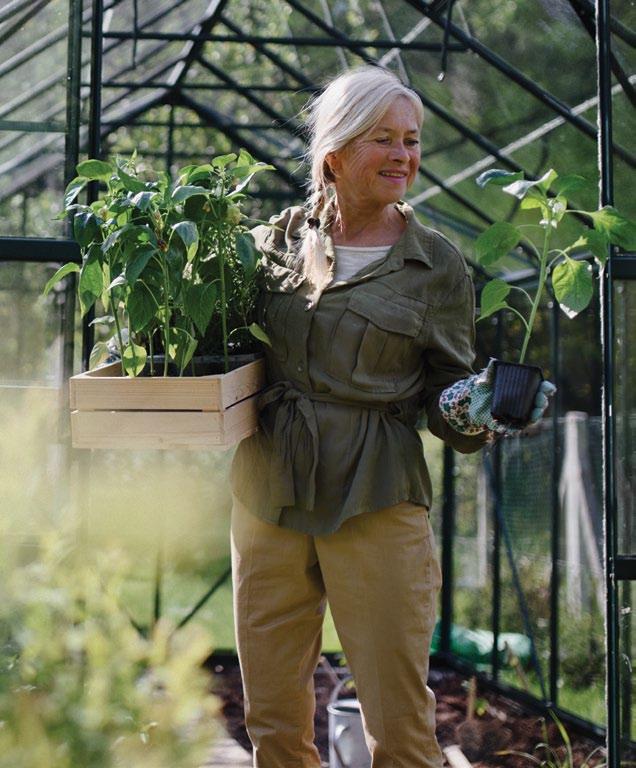

Sometimes, it is easier just to plunk the cuttings in a glass of water and wait for roots.
Expect your lipstick plant to bloom though the summer and into fall. P
Now you can finally have all of the soothing benefits of a relaxing warm bath, or enjoy a convenient refreshing shower while seated or standing with Safe Step Walk-In Tub’s FREE Shower Package!
✓ First walk-in tub available with a customizable shower
✓ Fixed rainfall shower head is adjustable for your height and pivots to offer a seated shower option


✓ High-quality tub complete with a comprehensive lifetime warranty on the entire tub

✓ Top-of-the-line installation and service, all included at one low, affordable price


















Now you can have the best of both worlds–there isn’t a better, more aff ordable walk-in tub!


Sweet clover, Melilotus, isn’t the kind of clover you look over with four leaves on it. Sweet clover is a tall plant, up to 6 feet, with dense spikes of small, tubular flowers, either yellow or white. It isn’t what you’d call a beautiful plant, but its stately candelabra uprightness has a certain handsome charm. It is commonly called “sweet” because it is loaded with nectar and gives off a sweet smell; it is called clover because it is part of the same family as clovers, the Fabaceae.
It’s a legume that had its origin in Eurasia but is well entrenched in North America. Often, it is used here as green manure cover crop. Honeybees enjoy the abundant nectar from flowers that bloom for weeks and it makes a lovely honey with tastes described as floral and creamy.
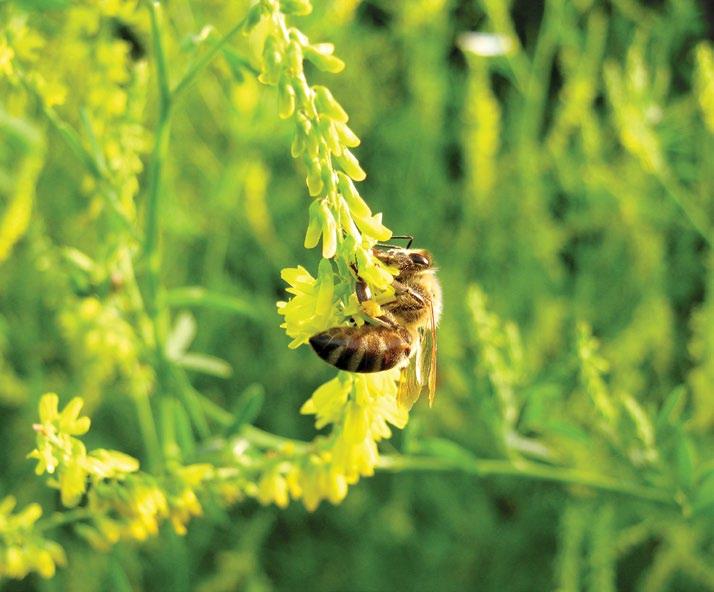
It can be used for livestock feed, but that requires care; it contains coumarin, which can cause bleeding disorders if consumed in large quantities. There are some varieties that are lower in coumarin, and certain harvest and storage methods can help manage potential risks.
So why would farmers risk feeding it to their animals? Because it is very nutritious, rich in fibre, minerals and vitamins, and is a good source of protein. It grows vigorously and tolerates drought better than other forage crops. Its sweet smell can attract animals and, though it has a bitter taste, is tolerated by hungry livestock.
As a cover crop, the plant has deep taproots that penetrate the soil, helping to alleviate compaction. Sweet clover is an annual or biennial that shades the soil around it, and its vigorous growth habit outcompetes weeds. Furthermore, it’s a legume, which adds usable nitrogen to the soil.
If you accept that it is a good cover crop, is good for bees, can feed animals and isn’t too bad looking, what’s the problem with it? Of course, it is non-native, which rankles some people. Worse is the number of seeds it produces. All
By shauna dobbiethose little flowers make little seeds, and those little seeds persist in the soil for upwards of 30 years. We are not getting rid of sweet clover anytime soon.
There is one more good thing about it, though. The yellow sweet
clover, Melilotus officinalis, is good at phytoremediation. It removes dioxins, which shouldn’t be in the soil. They are byproducts of fossil fuel burning, PCBs, metal recycling, chlorinated pesticides and the manufacture of paper. P
On June 17, National Garden Day, the Canadian Garden Council unveiled the inaugural slate of inductees for its Garden Hall of Fame. The list includes horticulturalists, designers, teachers and other advocates of gardening who have significantly influenced Canada’s garden culture.
“Together, our committee made the decision to honour 22 historical leaders as the first Garden Hall of Famers,” said David Galbraith, chairman of the committee who laboured over the list. “These pioneers have fostered innovation and contributed to the growth of the garden community and horticulture industry in Canada and beyond.”
Here are the 22 distinguished individuals and a little bit about what they achieved.
• • •
Catharine Parr Traill (1802 to 1889) was an author and naturalist who settled in Ontario, where she wrote about pioneering and the nature surrounding her. She documented the plants of the Canadian wilderness and their uses.

Father Léon Provancher (1820 to 1892) founded the Natural History Society of the Séminaire de Quebec. He collected and catalogued specimens of plants in and around Quebec City.
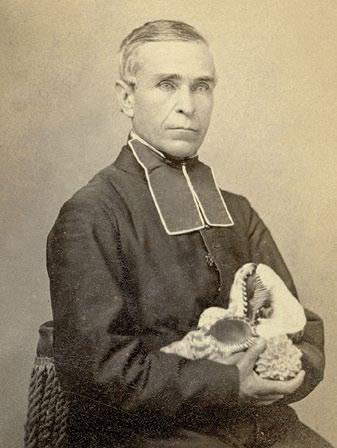
Delos White Beadle (1823 to 1905) was a horticulturalist and journalist in St. Catharines, Ontario, whose father

owned a nursery that cultivated fruit trees. He wrote Canada’s first gardening guide, Canadian Fruit, Flower, and Kitchen Gardener.

Auguste Dupuis (1839 to 1922) haled from the village of Aulnaies, Quebec. He imported fruit trees from the US and France, and he opened a nursery. He is responsible for bringing many varieties of apples, plums, cherries, currants and pears to Canada.
William Tyrrell Macoun (1869 to 1933) was a horticulturalist at the Central Experimental Farm in Ottawa. He was a proponent of the Canadian McIntosh apple, saying it was “one of the finest appearing and best dessert apples grown.”
Brother Marie-Victorin (1885 to 1944) fought to have the Botanical Garden of Montreal built. The garden was initially approved by Mayor Camillien Houde in 1929, but subsequent administrations weren’t happy about it. He promoted it at every opportunity and prevented it from becoming a military flight school during World War II.
Lorrie and Howard DuningtonGrubb (1877 to 1945 and 1881 to 1965) were two landscape architects who founded Sheridan Nurseries in Ontario in 1913. They were very active in Toronto society, writing articles on garden design and giving lectures. With a group of landscape architects, they founded the Canadian Society of Landscape Architects in 1934.
The Hon. Thomas Baker McQuesten (1882 to 1948) was a politician and a member of the Board of Park Management of Hamilton, Ontario. He is considered to be the founder of the Royal Botanical Gardens in Ontario.
Jennie Butchart (1866 to 1950) married the industrialist Robert Butchart, who operated a cement factory in the community of Brentwood Bay on Vancouver Island in BC. After the factory depleted all the limestone deposits in the area, leaving a horrible eyesore, Jennie embarked on an ambitious project to transform the area into a garden. That was the
beginning of Butchart Gardens. She continued to expand the gardens throughout her life.

Faith Fyles (1875 to 1961) was a botanical illustrator who toured western Canada collecting around 800 plants of 44 different species for the Central Experimental Farm. She painted plants, documenting the colours and forms.
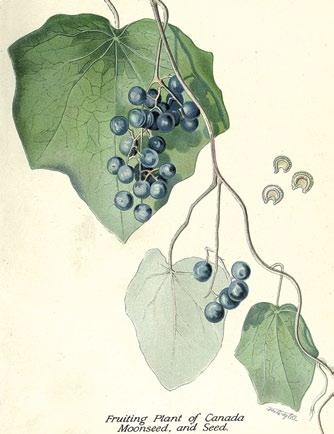
Isabella Preston (1881 to 1965) worked at the Central Experimental Farm in Ottawa, where she developed a number of lilac cultivars, known now as Preston lilacs. She also developed cultivars of lilies, crab apples, Siberian irises and roses.
Elsie Reford (1872 to 1967) was the gardener behind Les Jardins de Metis and Reford Gardens in Eastern Quebec. Although she had debilitating seasonal allergies, she worked to rehabilitate the soil around her fishing lodge and supervise the construction of 20 acres of gardens. Astonishingly, she did not start gardening until she was 53.
Frank L. Skinner (1882 to 1967) established a nursery in the western Manitoba area of Dropmore. The family homestead became an experimental station and Skinner introduced several cultivars, including the ‘Isabella Skinner’ rose, ‘Dropmore’ pear, ‘Dropmore Scarlet’ honeysuckle and ‘Hiawatha’ lilac.
underwent a couple of name changes and the acquisition of Dominion Seeds before returning, in 2015, to their original trademark.
Henry Marshall (1916 to 1994) was the researcher at the Morden Agriculture Research Station, in Manitoba, who developed 35 new varieties of vegetable and ornamental plants. He developed the Parkland roses as well as a lily, a muskmelon, a pea and two tomatoes.
Dr. Joseph Brueckner (-- to 1994) was a rhododendron enthusiast who developed hybrids to weather Canadian winters. He registered 18 cultivars with the Royal Horticultural Society. He did most of his work in Mississauga, Ontario, and there is now a park in the city featuring many of his plants.

Felicitas Svejda (1920 to 2016) was
an agricultural scientist who worked at the Central Experimental Farm in Ottawa where she developed the Canadian Explorer Rose series. She also worked on developing ornamental shrubs, including five weigelias, two forsythias and three mock oranges.

Tony Huber (1938 to 2019) was the hybridizer who developed ‘Gold Mound’ spirea, that charming pink spirea shrub with the chartreuse leaves, which is in many gardens around the world today. He worked for the W H Perron Seed company, living in Laval, Quebec. He was well known in the iris community for his work, making the very difficult crossing of Iris versicolor with Iris enseta.

Cornelia Oberlander (1921 to 2021) was the landscape architect who worked on the National Gallery of Canada in Ottawa, Van Deusen Botanical Garden and Robson Square in Vancouver, the Northwest Territories Legislative Assembly in Yellowknife and other notable sites. She began her career designing the grounds around low-income housing, including vegetable gardens and fruit trees in the landscapes.
Wilfrid-Henri and Louis Perron (1897 to 1977 and 1907 to 1990). W H Perron started the first bilingual seed company in 1930 in Montreal. His brother Louis became the first French-speaking landscape architect in Canada. W H Perron and Company Larry
Larry Hodgson (1954 to 2022) was, among other things, a beloved member of the editorial board for Canada’s Local Gardener. He was a garden writer in both English and French. He published 65 books, wrote for papers and magazines, and maintained a daily blog in both languages for six years. He is the only person on this list that I have met, but if the others were even half as enthusiastic and knowledgeable about gardening, these initial inductees are worthy of the honour indeed. P
Catalpa is typically considered a Zone 4 tree, but adventurous gardeners may attempt to grow it in Zone 3. Why not? Its blooms resemble orchids on large, upright panicles, and its leaves are incredibly huge. People may pass by these trees, unaware of their uniqueness until one day, they notice something special about them. It could be the sweet scent of the flowers or the long, hanging bean pods.
We're referring here to the northern catalpa, Catalpa speciosa, native to a small region in the US around the Mississippi and Ohio Rivers. There's also a Chinese species, C. ovata, occasionally grown in Canada, which shares similar hardiness but has smaller size and yellowish flowers compared to C. speciosa
Scan


out this video to find out how to identify catalpa trees with Don Leopold.
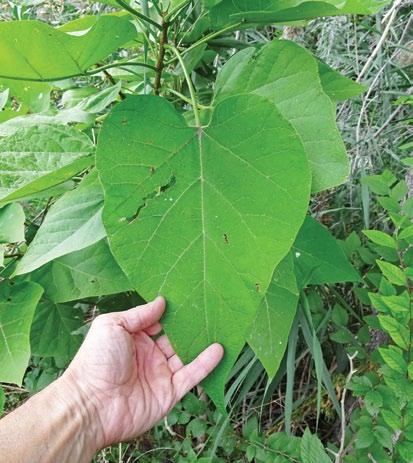
Check
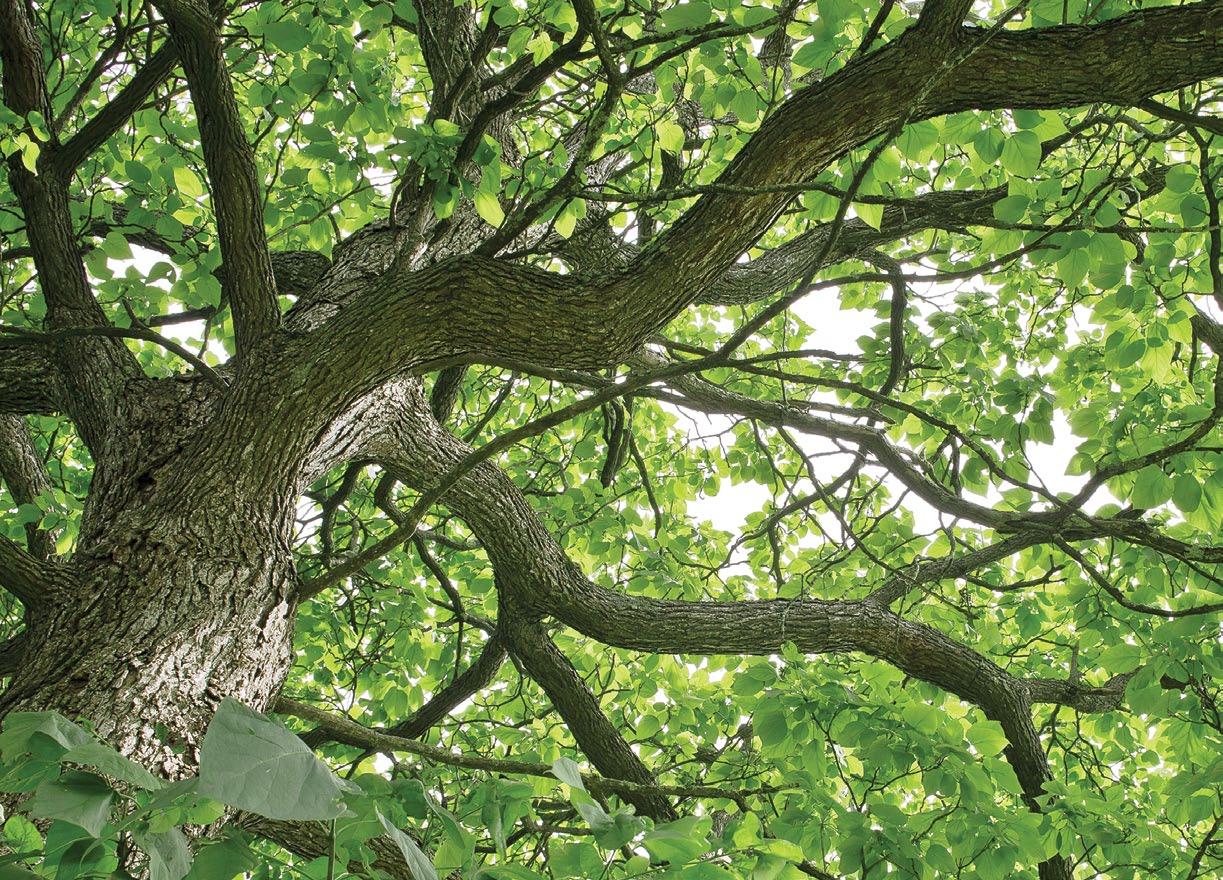
The flowers bloom in late spring and emit a fragrance likened to that of sweet pea, lilac, vanilla, or jasmine. The northern catalpa's flowers are white with a few deep yellow stripes and burgundy spots at the throat. In regions prone to late frosts, the tree may survive but not flower as frequently. In areas where it's marginally hardy, planting it in a sheltered location, such as the south side of a house (at least 20 feet from the wall) is recommended. Keep other vegetation in the yard and a tall fence to reduce wind exposure.

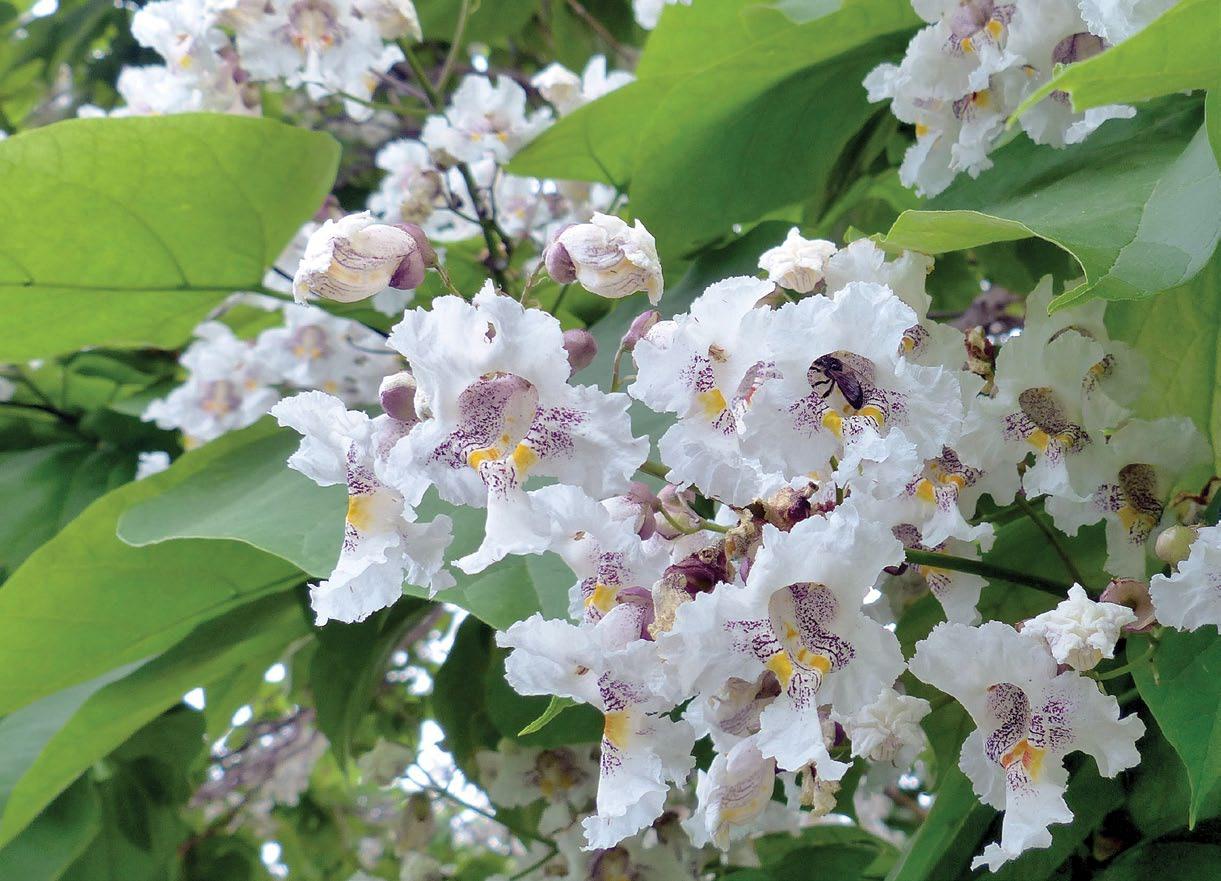
The foliage of the catalpa tree is impressive. The heart-shaped leaves can grow as long as 12 inches, initially medium green and changing to dull yellow in the fall. Some claim that the tree loses its appeal after the blooms fade, but in areas lacking large-leafed trees, catalpas remain a spectacular sight.
Besides the leaves and flowers, catalpas bear pods that are even longer, measuring 20 inches. The
pods start green and ripen to brown or black, containing seeds that are tufted on either end. Although they are a marvel to behold, the downside is that all things growing on trees eventually come down, leading to the catalpa’s somewhat negative reputation. Between the lengthy pods, large leaves, and fallen flower detritus, these trees can be a bit messy.
When planting a catalpa tree, one should be aware of this and keep a rake on standby. If you're particular about tidiness, rake up the fallen blossoms; otherwise, let them return to the earth. Watch out for slippery pods on walkways and, if in Zone 5 or above, collect and compost the pods since catalpas can become invasive in certain areas. As for the leaves, well, you need to rake up leaves in the fall regardless, so this is just one more tree contributing to the task (unless you prefer to leave the leaves be – to each their own). P
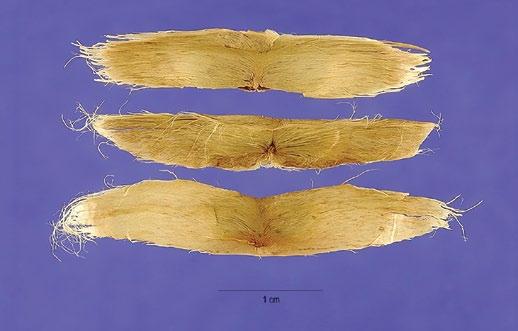

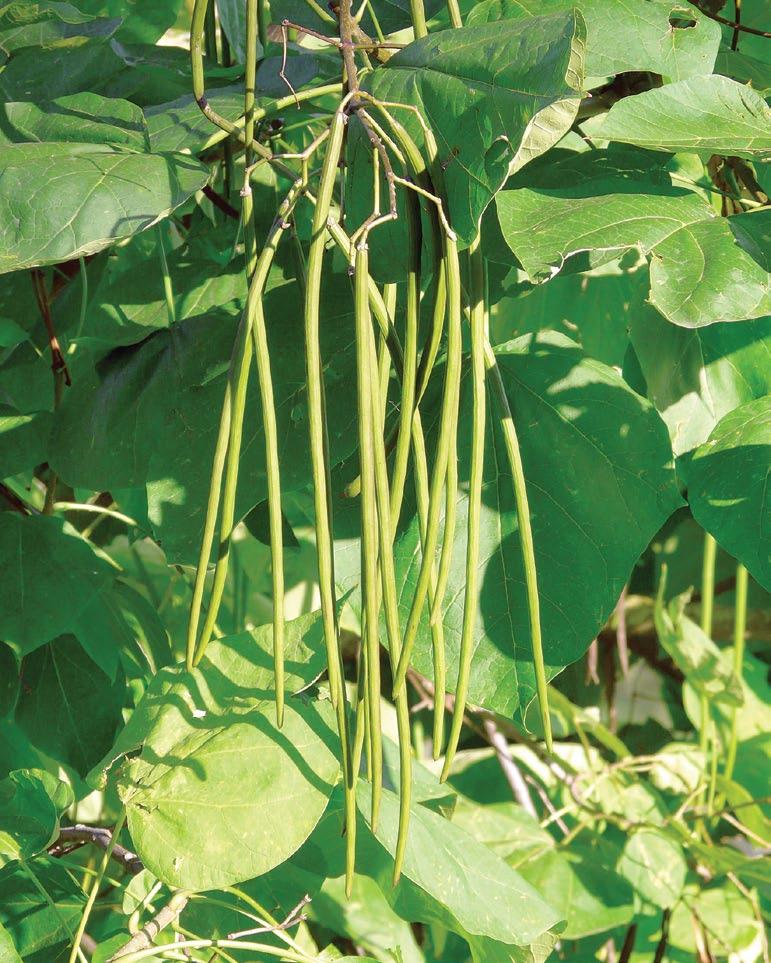

You love your perennial garden soooo much, you’d like to double or triple what you’ve got. But how do you do that without breaking the bank? There are ways. It depends on what plants you’d like to increase, and it takes a little time, but here are the methods that growers and expert gardeners use to make new plants.
Many perennials can be propagated by dividing the existing clumps; in fact, some plants need it. If you’ve noticed your formerly well-behaved clump is looking dead in the middle, it’s a sign it needs dividing. Dig up the mature plant and carefully separate it into smaller sections, making sure each section has sufficient roots and shoots. Replant the divisions in desired areas or in pots and provide appropriate care until they establish themselves.
Choose the right time to divide your
https://www.youtube.com/watch?v=gROmGmbJYeU


perennials. The ideal time is often during the early spring or fall when the weather is cool and plants are not in their active growth phase. In areas with a short autumn, divide in spring so that plants can settle in before the ground freezes.
Water the plant thoroughly a day or two before dividing it. This will help the roots retain moisture and make it easier to dig up the plant. Carefully dig up the clump using a garden fork or
shovel. Insert the tool into the soil a few inches away from the plant's base and gently lift the clump out of the ground. Be cautious not to damage the roots.
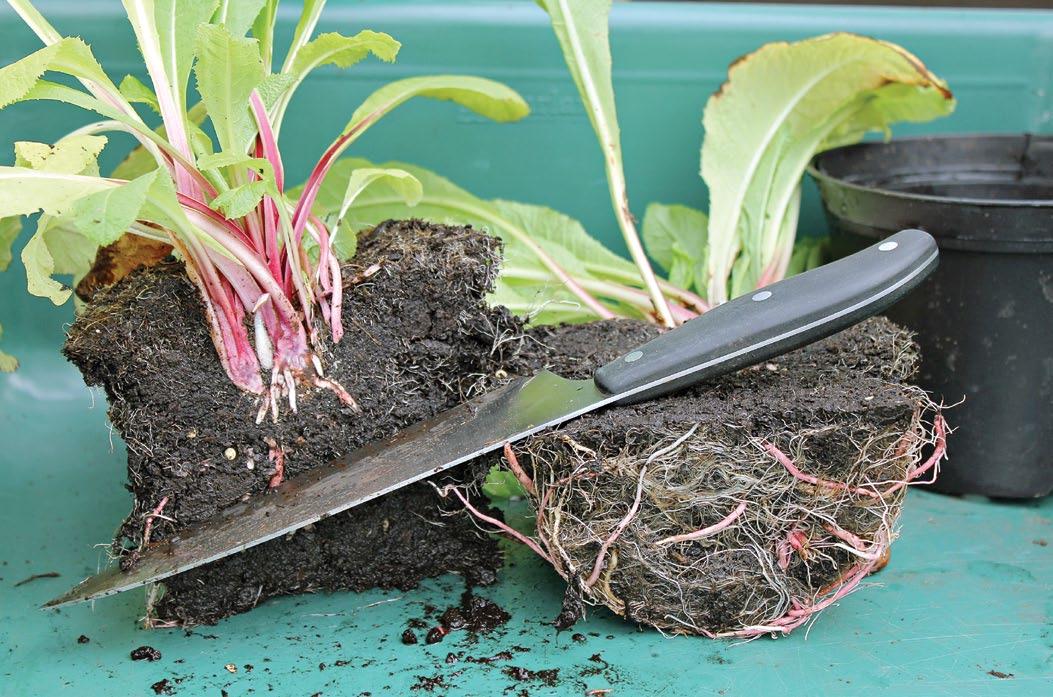
Once the plant is out of the ground, you can divide it into smaller sections. Depending on the plant, you can use your hands, a sharp knife, or even two garden forks inserted back-to-back to separate the clumps. Each division should have healthy roots and shoots. Trim back any excessive foliage or long roots to reduce stress on the divided plant. Remove any dead or damaged parts as well.
Choose the new planting location for each division. Dig a hole that is wide and deep enough to accommodate the roots comfortably. Place the divided sections in their respective holes, ensuring the crown (where the shoots emerge from the roots) is level with or slightly above the soil surface.
Many plant cuttings can be rooted in water (like the coleus cutting shown here). You can grow new clematis by layering or from stem cuttings.

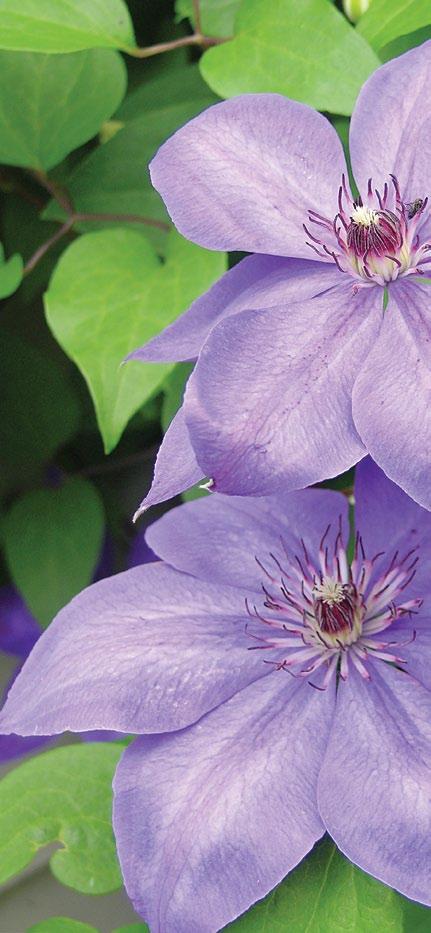
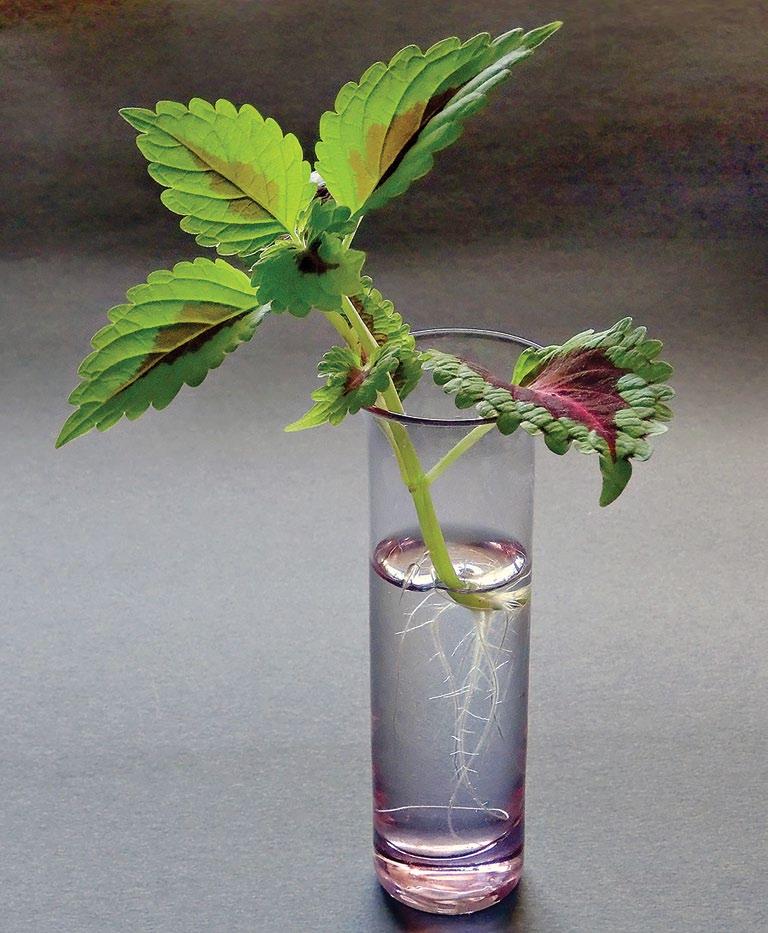
Water the newly divided plants thoroughly after planting to help settle the soil around the roots. Provide adequate moisture during the establishment period and monitor the plants for signs of stress. Mulching around the plants can help conserve moisture and suppress weeds.
Some perennials can be propagated from stem cuttings. Chrysanthemum, heliopsis, monarda, dianthus and aster is a shortlist of perennials that can be increased through cuttings. There are also many shrubs that will take to this method, including roses, hydrangeas and lilacs.
Choose a healthy, non-flowering stem from the parent plant. Look for a stem that is vigorous, free from diseases or pests, and preferably with a semi-hardwood texture (neither too soft nor too woody). Use a clean, sharp pair of pruning shears or a knife to make a clean cut just below a leaf node. The cutting should be around 4 to 6 inches long.
Strip off the leaves from the lower one-third to one-half of the cutting. This will prevent excess moisture loss and promote the growth of new roots. Apply rooting hormone (powder or liquid) to the base of the cutting. Some plants need it, others couldn’t care less.
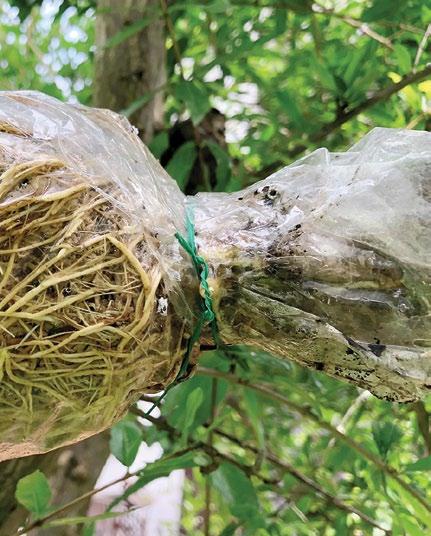
Fill a small pot or tray with a welldraining propagation medium, such as a mixture of perlite and peat moss or a commercial seed-starting mix. Make a hole in the medium using a pencil or your finger and insert the cutting into the hole, burying the lower portion with the stripped leaves. Mist the cutting with water and cover the pot or tray with a clear plastic bag or a propagation dome

https://www.youtube.com/watch?v=-gXMrsGlbXk


to create a humid environment. This helps prevent excessive moisture loss and encourages root growth. Place the container in a warm, well-lit area, but avoid direct sunlight to prevent overheating.
Check the cutting regularly to ensure the propagation medium remains moist but not waterlogged. Mist the cutting and the inside of the plastic covering if needed. Avoid overwatering, as it can lead to rot. Remove any leaves that show signs of decay or mold.
After a few weeks, gently tug on the cutting to check for resistance, indicating root growth. If the cutting resists being pulled out, roots have likely formed. At this point, you can gradually acclimate the cutting to lower humidity by opening the plastic covering for short periods each day.
Once the cutting has established a good root system (usually several weeks to a few months), it's ready for transplanting. Prepare a suitable pot or plant it directly in the garden bed, taking care not to damage the delicate roots. Provide appropriate care and monitor the new plant as it adjusts to its new environment.
As a variation on this theme, some plants can be propagated by leaf cuttings or root cuttings.
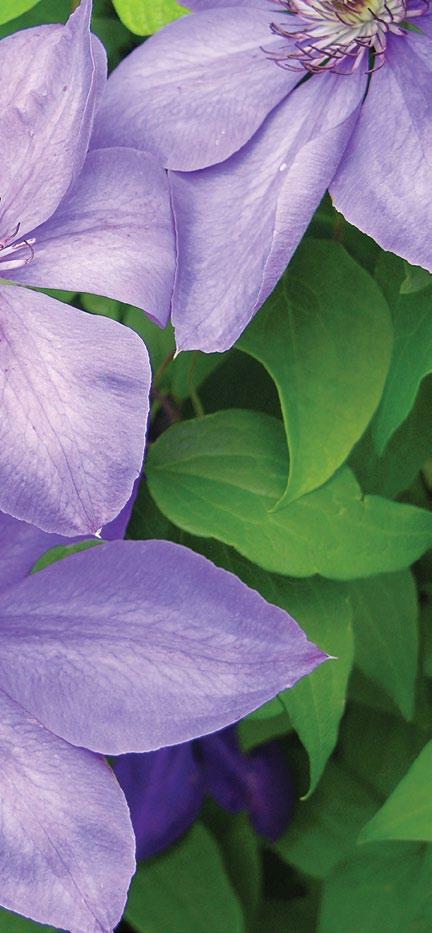
Layering
Layering is a technique where you encourage a stem of the plant to form roots while still attached to the parent plant. Bend a low-growing stem of the perennial to the ground, remove a small section of bark or make a shallow cut on the underside, and cover the wounded section with soil. Secure the stem in place with a U-shaped wire or a small stone. Keep the soil consistently moist until roots form, usually within a few months. Once roots develop, cut the stem from the parent plant and transplant it.
This technique is typically used for woody perennials and vines. You can also air layer a plant using a propagation pod – those plastic things you fill with soil and put around a stem, already cut, on a tree. (Google “propagation pod” if you haven’t seen them.) You can make your own propagation pod with a plastic bag or bit of plastic wrap.
Layering can take months for roots to form so it isn’t the best way to propagate herbaceous perennials, which can usually be propagated through other methods. It is great for increasing trees and shrubs, though.


And the resulting plant is already used to the climate it is growing in.
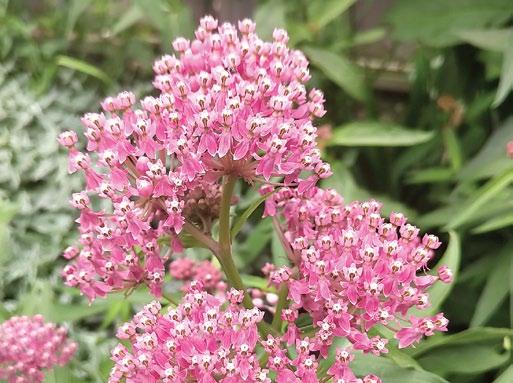
Some perennial plants will sow themselves. Others can take a long time. It may be that a seed requires cold stratification, or has a very tough seed coat, or a seed coat that has a germination inhibitor built in. Nonetheless, it can be fun to try to propagate the seeds from plants in your garden. Look for information (there will be a story in the next issue of Canada’s Local Gardener) on any plant you’d like to grow from seed ahead of time. Good luck! P
A great yard or garden begins with a great foundation. Reimer Soils has been providing the highest quality landscaping products for more than 40 years. With a complete range of top quality products and unmatched customer service, there is no reason to look any further than Reimer Soils for all your landscaping supply needs.

• Join a gardening club; the more gardeners you know, the more plants will find you
• Arrange a plant swap in your neighbourhood
• Look for plants on sale at the end of the season, or really any time outside of May to June
• Look for discount plants at the nursery; those that have outgrown their pots are just waiting for someone like you

• Buy the smallest plants available; they will grow!
• Look on Kijiji, Facebook Marketplace and in your newspaper’s want ads regularly.

Nothing lives without water and in normal years, plants know just how to get it. Weeds (usually plants that have good survival skills) such as dandelions, dig way down deep. Canada thistle roots can reach down 16 feet or more to find moisture.
However, much of what we plant for food and for beauty comes from other places and may not have developed this kind of resilience. The plants we put into containers to hang or adorn our decks or patios are the most dependent. Vegetables come a close second, especially in the early stages of their development and depending on the plant.
The first step in assessing how much water your veggie garden will need is an examination of the soil. If it is sandy, that guarantees good drainage, but good drainage also indicates the need to keep an eye on the moisture content.
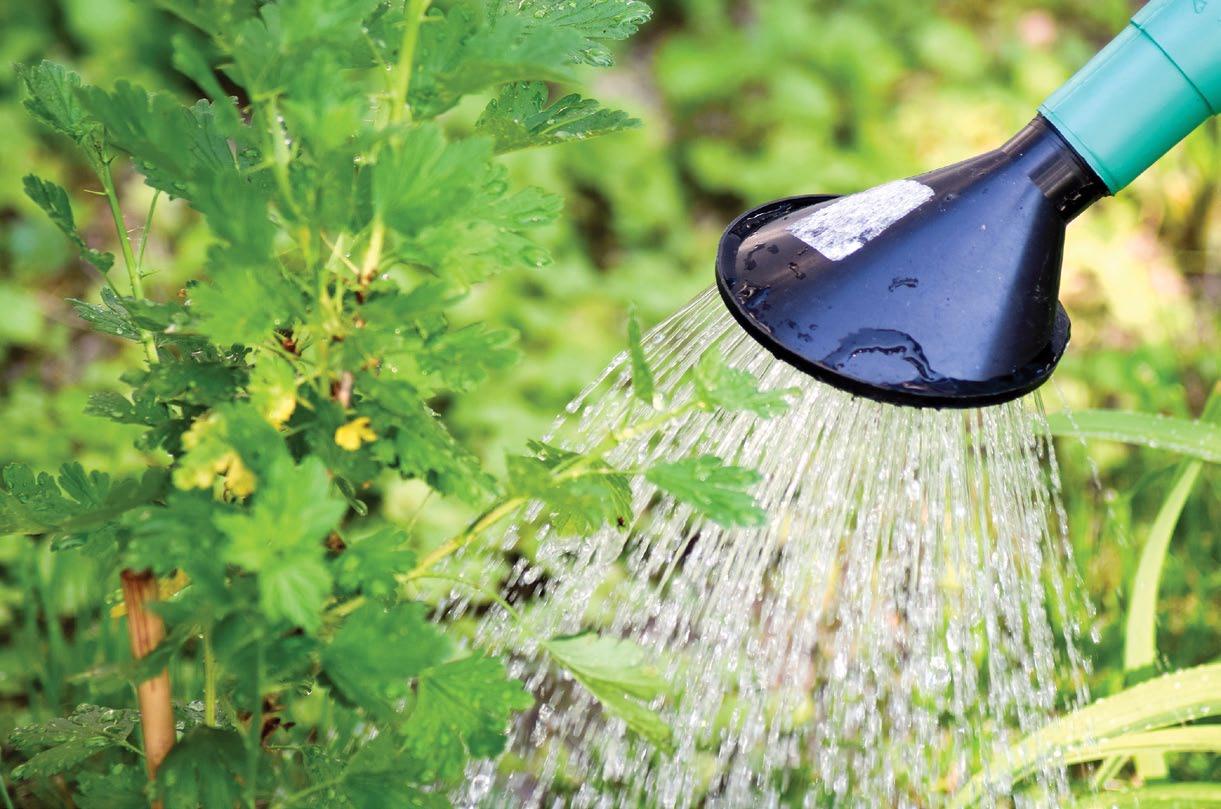
The sandiest soil may benefit from amendment with an organic material such as compost or well-rotted manure. If this is the case, you may find it necessary to amend the soil annually. Certain organics break down more quickly than others.

The second thing to check is root depth. Plants such as cucumbers, spinach, cabbage, celery, corn, onions, leeks, carrots, broccoli, radishes, and Brussels sprouts have shallow roots that need to be able to access water nearer to the surface. They will need more careful supervision and more watering.
Vegetables with medium depth roots include beans,
turnips, kale, lettuce, peas, peppers, potatoes, rutabagas, and summer squash. They will need a little less attention.
Finally, deeply rooted vegetables including watermelon, winter squash, pumpkins, parsnips, asparagus, tomatoes, rhubarb, and if you can grow them, sweet potatoes, will need less attention.
That is just the start though. Plants that produce fruit will need more watering during their flowering period and while their fruit is growing. Consider tomatoes, which are extremely sensitive to watering habits. The most important requirement is consistency. Water the same amount each time. If you water too little or allow them to dry out, you will end up with blossom end rot. If
Celery likes more water than most vegetables.
you water too much, you will have fruit splitting. Other fruit bearing vegetables include squash, peppers, and watermelon.
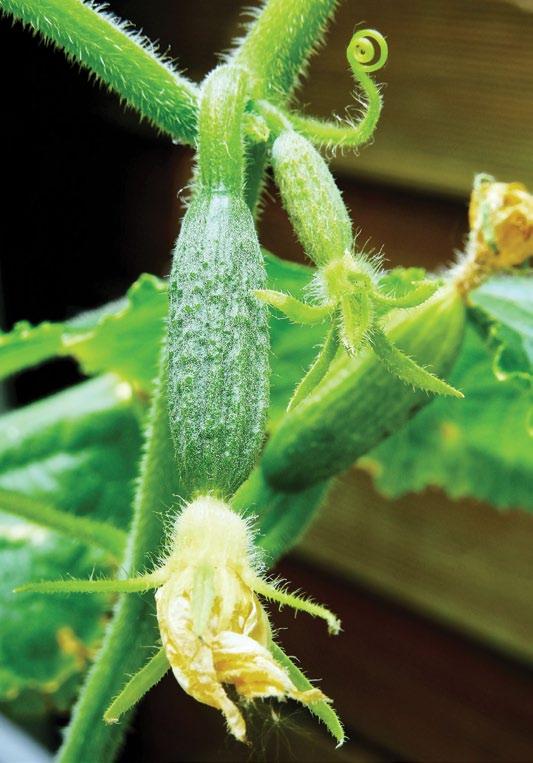
Root vegetables, such as beets, carrots and radishes, need to have evenly moist conditions to encourage root growth. Water more deeply and consistently throughout their life cycle.
Plants such as celery or cauliflower need to be well watered, especially while their heads and leaves are developing. Indeed, celery, asparagus, cabbage, and arugula enjoy moister than usual soil. Celery is also a nutrient hog, so be sure to fertilize when you water. Peas also require damp soil to perform at their best.
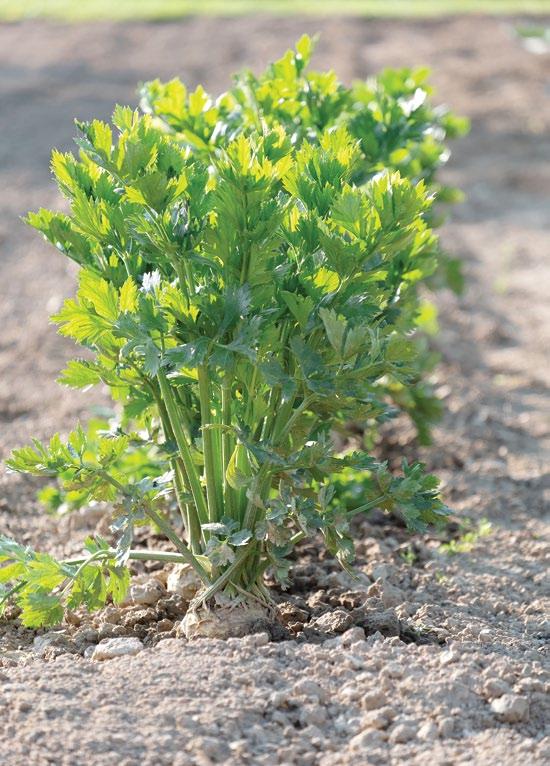
If you can, water early in the morning, particularly if you are using a sprinkler or garden hose. The leaves need time to dry in the sun to help avoid fungal disease. If using a drip or soaker hose, morning or evening are both fine. Avoid high noon because water evaporates in the heat of the sun.
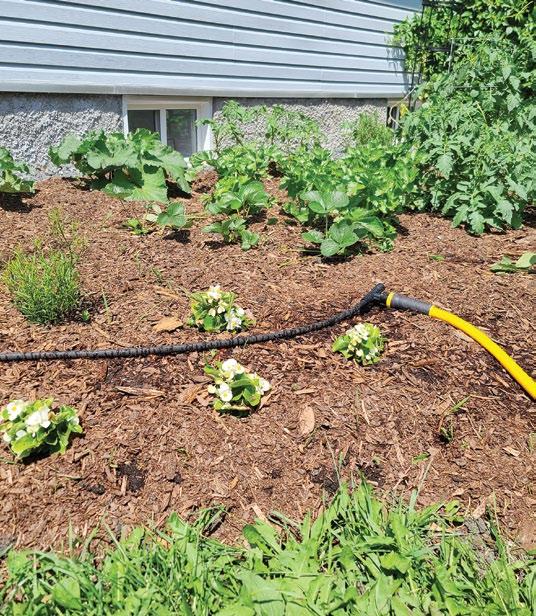
Water timing for container plants is the same as for all others; however, frequency for containers could be as seldom as once a week for very large pots to twice a day for smaller pots in very hot weather. Use your eyes and finger to determine when. Remember, if you are growing tomatoes or peppers, do not let them dry out! Mulch may be useful to help keep tomatoes evenly moist.
Also note that terra cotta containers “breathe” and will dry out more quickly than glazed ceramics or plastics.
Raised gardens also need to be watered more frequently than in-ground gardens. Keep an eye on their hydration and try to create a schedule so that your gardens don’t dry out inadvertently.
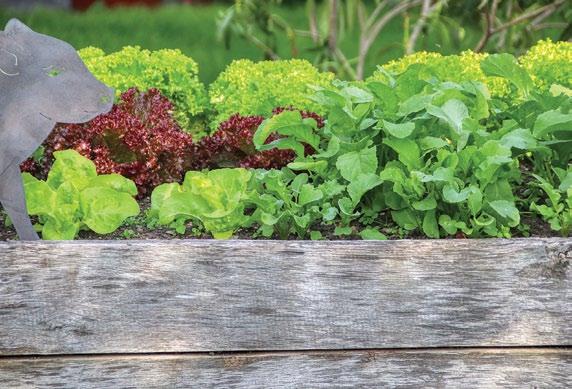
If you don’t have too many containers (I know, what is “too many”?) water with a watering can so that you can deliver fertilizer at least twice a month or even weekly. Container plants don’t have the ability to reach deeper in the soil to find minerals nor do they have the same mix of microbes busy breaking down organics for them to use.
Water thoroughly, letting the water run out the drainage holes. Do not water if the plant is still wet, however. How to water in-ground gardens
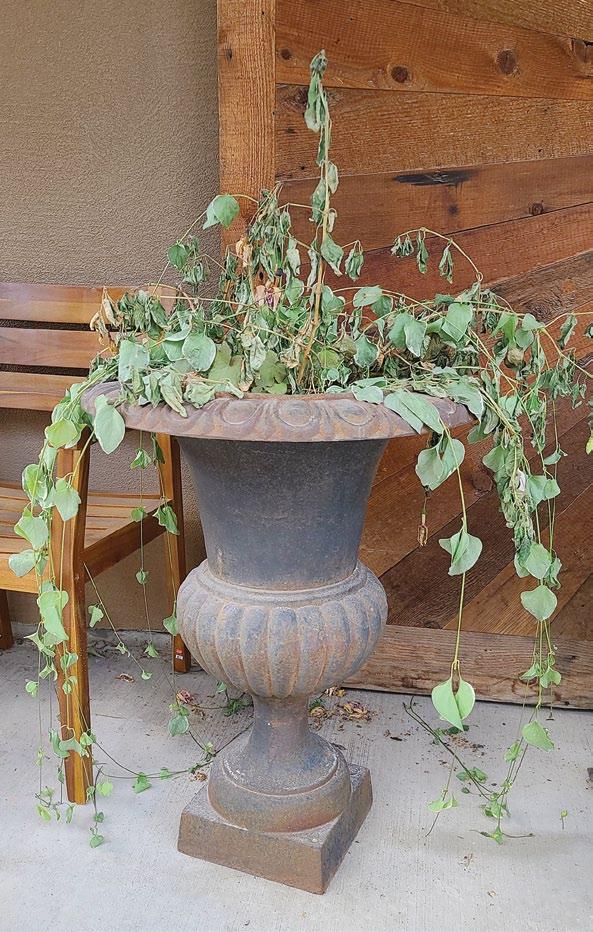
While not a science, soaker and drip systems water at ground level and avoid wetting leaves, allowing you to safely water any time of the day. It is also less labour intensive although standing and watering the garden can be a very revitalizing activity.
If you are hand watering in-ground plants, remember to soak the ground around the roots, say in a circumference of half a dozen inches, rather than the leaves or where the plant emerges from the ground. Water deeply and less frequently. A general rule would be an inch per week depending on the weather. This will encourage roots to penetrate deeper, conserving water and improving plant health.
Should you water perennials?
Perennials should be watered through their first season in the garden. Unless it is an extremely hot, dry year, I do not water perennials once they’ve been established. They need to send their roots down deep, where they will find not just more moisture but also more minerals. Mulching is a good thing to retain moisture.
If you live in an area where there is a great deal of clay in the soil, you may want to pull the mulch back a bit in a very wet year to avoid water logging. Mulch on sandy soils can be left in place.
What about trees and shrubs?
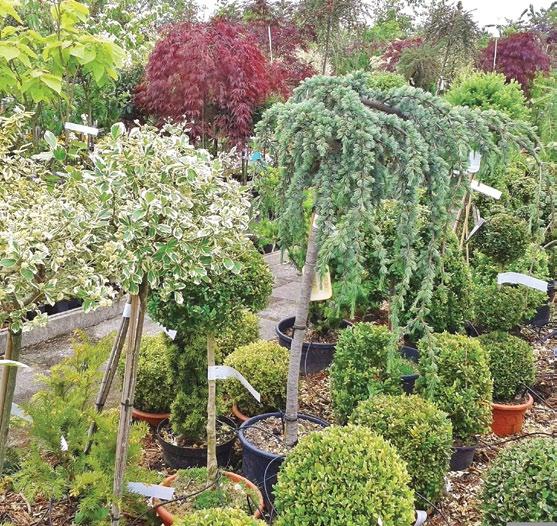
Newly planted trees and shrubs need to be watered deeply and frequently for the first year. Be sure to water both the roots and the surrounding soil to encourage the new roots to branch out. Slow watering using a drip system, or a water bag is best.
All trees, but especially evergreens, benefit from being watered in fall just before freeze up. Evergreens continue to expire moisture throughout the entire winter, and it is important that they have a resource to draw from. P
While fresh water isn’t scarce in Canada (look at a map), there is no sense wasting it. Here’s what you can do.
Mulch. Applying a layer of organic mulch around plants helps to retain soil moisture by reducing evaporation. Mulch also acts as an insulating barrier, regulating soil temperature and preventing weed growth.
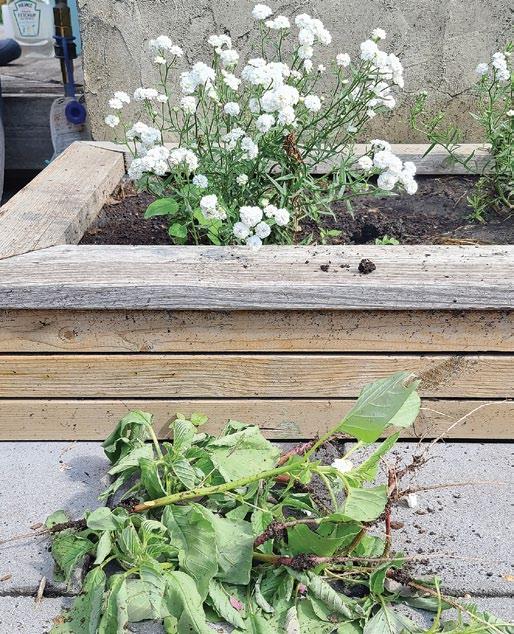
Irrigate efficiently. Using efficient irrigation methods ensures that water is delivered directly to the root zone of plants, reducing wastage. Drip irrigation systems, soaker hoses, or micro-sprinklers are effective options. Avoid overhead watering methods like sprinklers, as they can result in water loss through evaporation and wind drift.
Water at the right time. Water your garden early in the morning or late in the evening to minimize water loss due to evaporation. Avoid watering during the hottest part of the day when evaporation rates are highest.
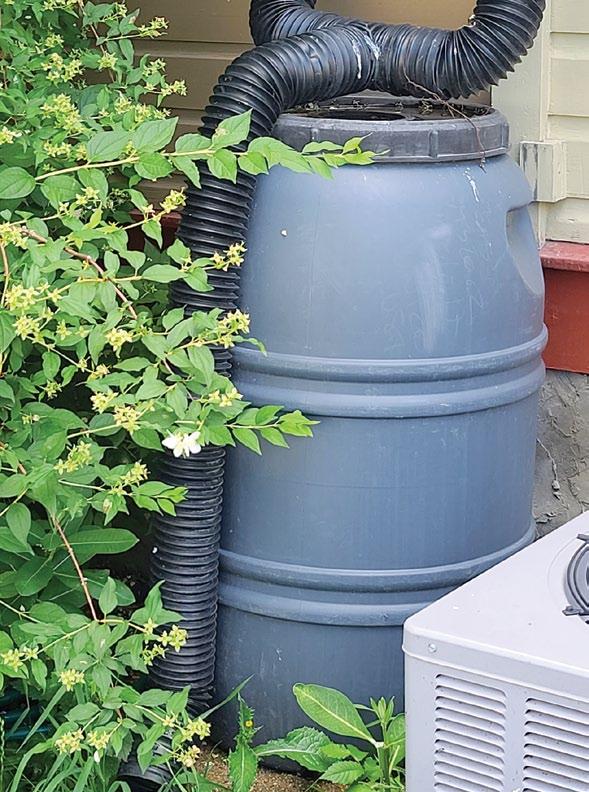
Water deeply and infrequently. Instead of shallow, frequent watering, which encourages shallow root growth, deep watering encourages plants to develop deep root systems that are more resilient to drought. Water the soil thoroughly but less frequently, allowing it to dry out between watering sessions.
Harvest rainwater. Collecting rainwater from rooftops and storing it in barrels or tanks can provide a sustainable water source for your garden. This stored rainwater can be used during dry spells, reducing the need for tap water. Prepare your soil. Amending the soil with organic matter, such as compost, improves its water-holding capacity. It enhances drainage in clay soils and improves water retention in sandy soils, reducing the need for frequent watering.
Group plants. Grouping plants with similar water requirements together helps to avoid overwatering or underwatering certain areas of the garden. This practice allows you to target irrigation more efficiently, matching the needs of specific plantings.
Proper lawn care. Lawns require a significant amount of water to stay green. Consider reducing the size of your lawn or replacing it with drought-tolerant ground covers or native plants to minimize water usage. Some municipalities encourage you to let your lawn go dry and yellow during the hottest part of the summer.
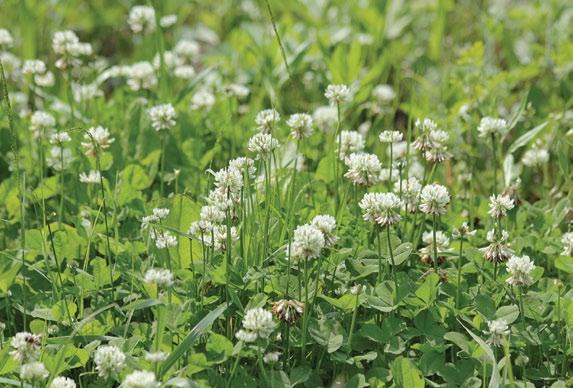
Your perennial garden is growing beautifully, your vegetable gardens produce bountifully, your baskets spill over with annuals … what’s next? A water garden, of course!
Ponds can add a visually appealing element to a garden, creating a focal point and enhancing its overall beauty. The sight and sound of flowing water, along with the presence of aquatic plants and fish, can create a tranquil and calming atmosphere, providing a space for relaxation and enjoyment.
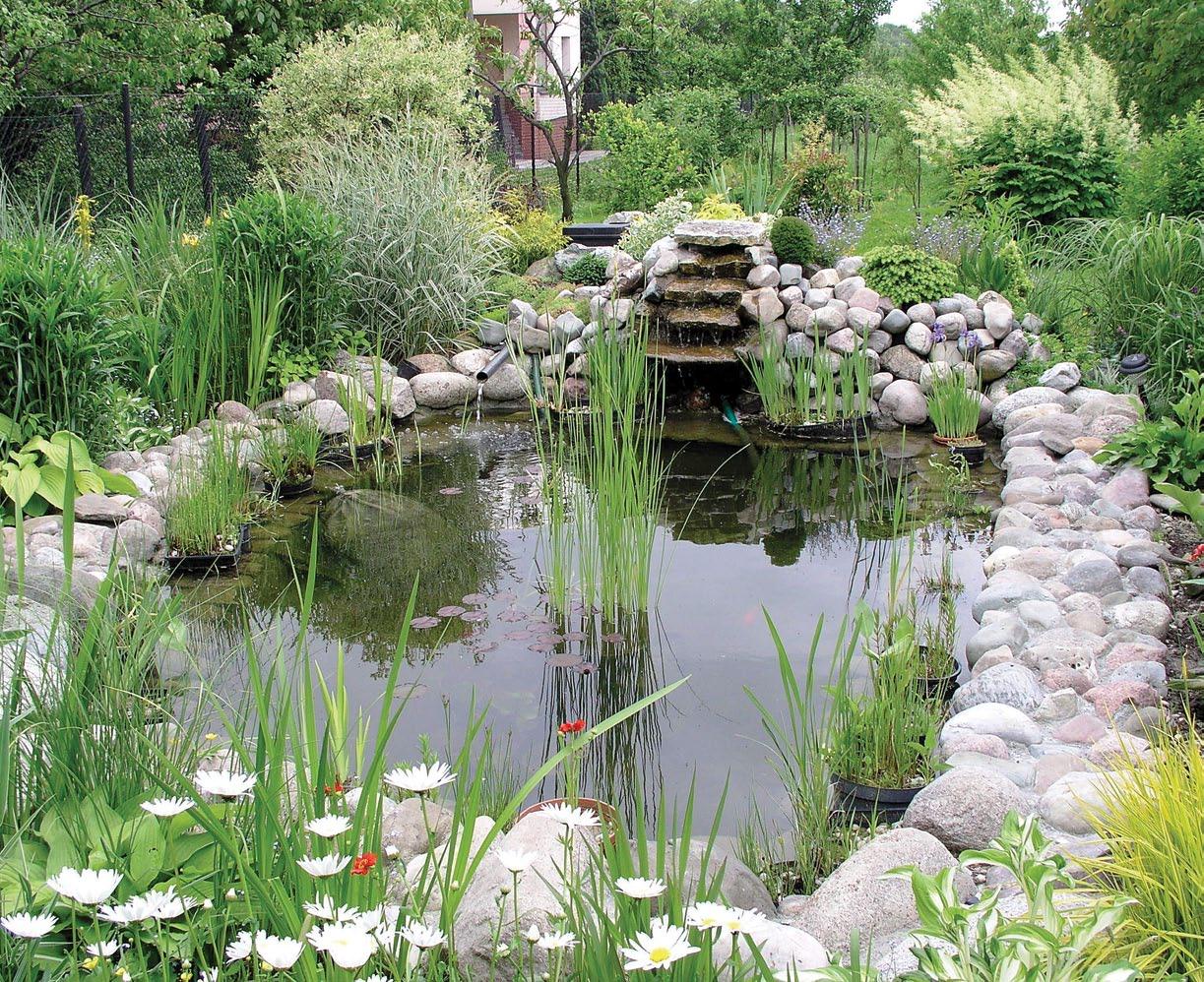
They can also provide a valuable habitat for various wildlife, including frogs, dragonflies, birds, and beneficial insects. By creating a pond, a gardener can attract and support a diverse range of organisms, promoting a balanced ecosystem and fostering biodiversity in their garden. And some of those organisms are really useful; aquatic insects, such as dragonflies and water bugs, are predators of garden pests like mosquitoes and aphids. By establishing a pond, a gardener can encourage these beneficial insects to thrive, thereby naturally controlling pest populations and reducing the need for chemical pesticides.
Best of all, ponds offer an ideal environment for growing a wide range of aquatic plants, such as water lilies, irises, and submerged oxygenators. These plants not only add beauty and color to the pond but also contribute to its ecological balance by oxygenating the water, providing shelter for aquatic organisms, and filtering pollutants.
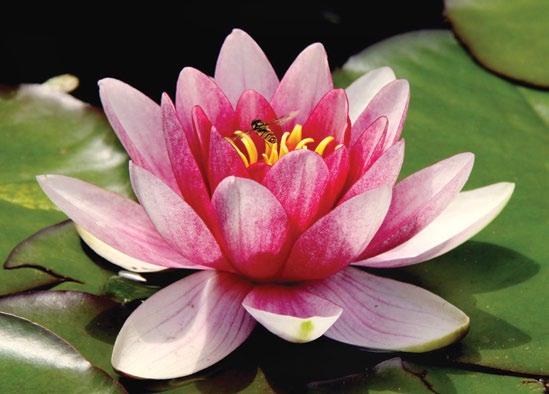

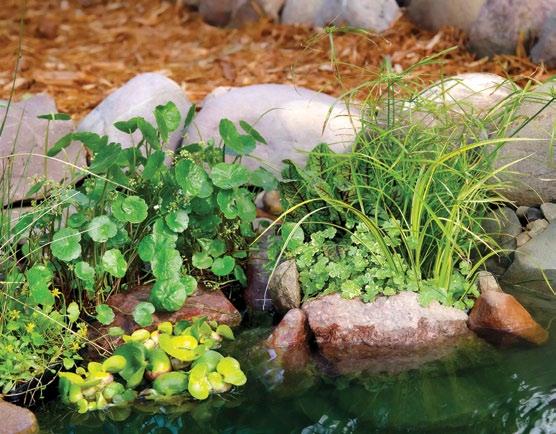
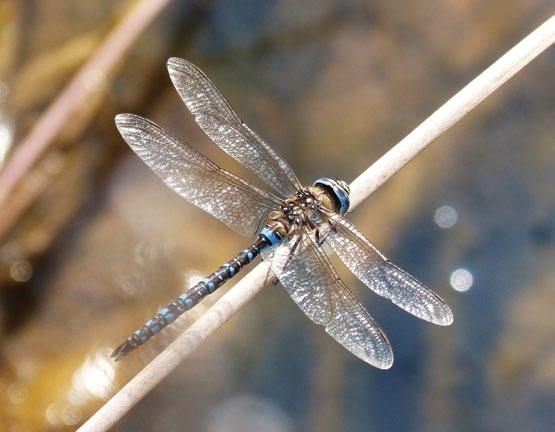
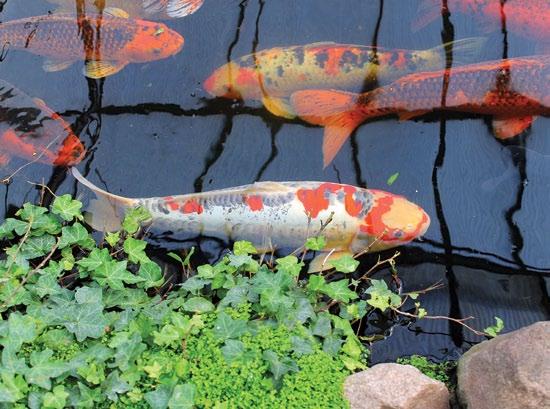
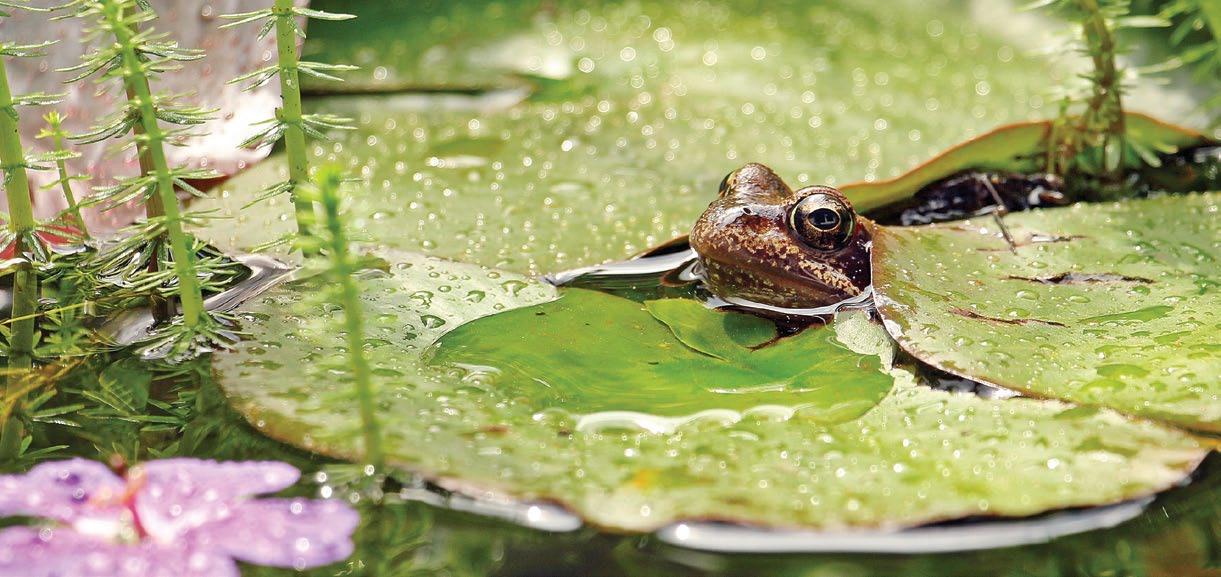
We’re not suggesting that you can just follow these steps and build yourself a pond without knowing anything else about it, but this narrows down what you do need to know. If you’re thinking of taking on a new project, here are the steps to building and maintaining a pond.
1. Plan and design:
• Determine the size and shape of your pond.
• Choose a suitable location that has adequate sunlight and avoids tree roots or utility lines.
• Consider the purpose of the pond, such as wildlife habitat, decorative feature, or fishkeeping.
• Sketch a design that includes features like shelves, ledges, or waterfalls.
2. Obtain permits:
• Check with your local municipality or relevant authorities to determine if any permits are required for pond construction.
3. Gather materials and tools:
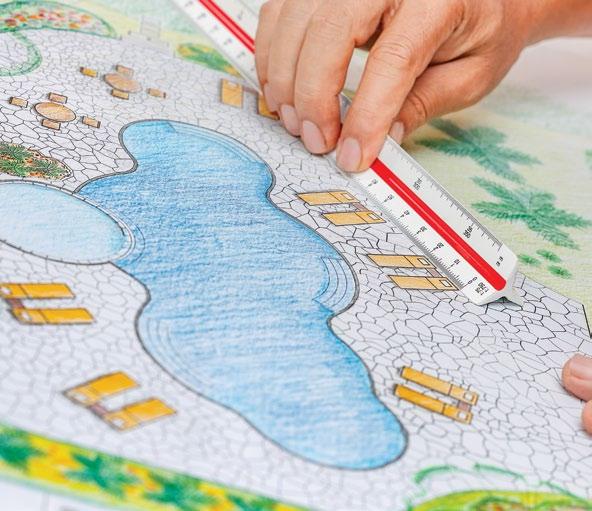
• Pond liner (EPDM rubber or PVC)
• Underlayment
• Pump and filtration system
• Rocks, gravel, or other decorative elements
• Shovels, rakes, and a wheelbarrow
• PVC piping (if required)
• Plants and fish (optional)
4. Mark the pond area:
• Use stakes and a string or a hose to outline the shape and size of the pond on the ground.
5 Excavation:
• Begin digging within the marked area, gradually creating the desired depth and shape for the pond.

• Ensure the sides are sloped to prevent collapse.
• Create shelves or ledges for aquatic plants, if desired.
• Remove any sharp objects, rocks, or debris from the excavation area.

6. Prepare the pond base:
• Add a layer of underlayment material to protect the pond liner from punctures or damage.
• Smooth out the underlayment and ensure it covers the entire excavated area.
7. Install the pond liner:
• Carefully place the pond liner over the underlayment, ensuring it extends over the edges of the excavation area.
• Gently press the liner into the shape of the pond, avoiding wrinkles or folds.
• Use rocks or other heavy objects around the perimeter to hold the liner in place temporarily.
8. Create the filtration system:
• Install the pump and filtration system according to the manufacturer's instructions.
• Connect the necessary plumbing, including pipes and hoses, to ensure proper water circulation and filtration.
9. Decorate and fill the pond:
• Add rocks, gravel, or other decorative elements around the pond edge.
• Gradually fill the pond with water, smoothing out wrinkles in the liner as it fills.
10. Test and adjust:
• Start the pump and filtration system to ensure proper functioning.
• Make any necessary adjustments to the water flow, filtration, or positioning of equipment.
• Allow the pond to settle for a day or two before adding plants or fish.
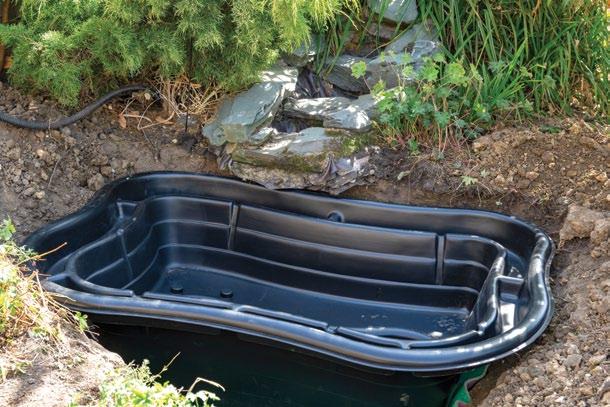
11. Add plants and fish:
• Introduce aquatic plants, such as water lilies, floating plants, or submerged oxygenators, according to your design and preferences.
• If desired, add fish that are suitable for the pond size and climate, ensuring proper acclimatization.
12. Maintenance and care:
• Regularly monitor water quality parameters like pH, ammonia, and nitrate levels.
• Clean the pond regularly by removing debris, leaves, and excess plant growth.
• Trim and maintain aquatic plants as needed.
• Adjust the pump and filtration system as necessary.
• In most areas of Canada, you’ll need to take your fish inside for winter. P
Fountains. Fountains come in a wide range of styles and sizes, from small tabletop fountains to large, elaborate designs. They typically feature a decorative structure with water flowing or spraying from it. Fountains can be standalone or incorporated into ponds or pools.
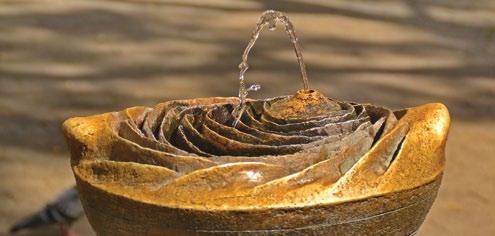
Bubbling rocks. Bubbling rocks, also known as rock bubblers or bubbler fountains, consist of a large decorative rock with water bubbling out from the top. They create a gentle and serene effect and are often used as standalone features or as part of a larger water feature.
Water spitters. Water spitters are decorative sculptures or statues that expel water in a playful or whimsical manner. They come in various shapes and designs, such as animals, mythical creatures, or abstract forms, and can be placed in ponds or standalone basins.
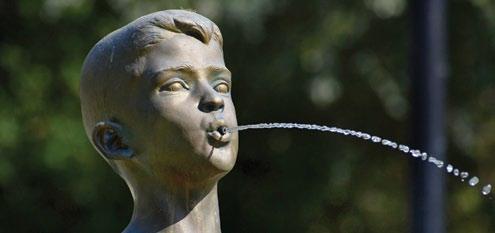
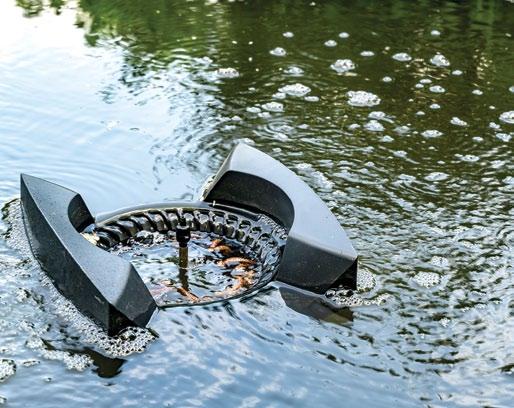
Reflecting pools. Reflecting pools are shallow pools of water designed to reflect the surrounding landscape or architecture. They provide a sense of calmness and elegance and are often used in formal gardens or outdoor spaces with architectural features.
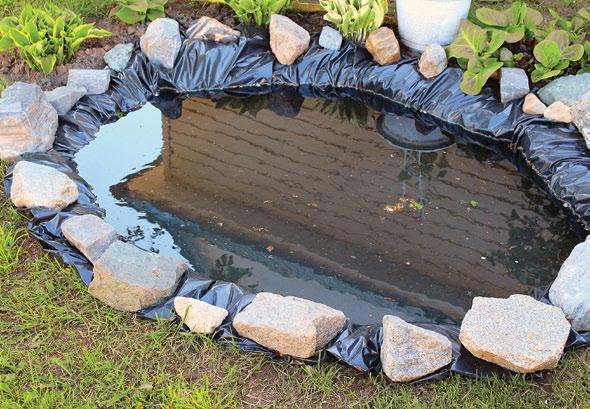
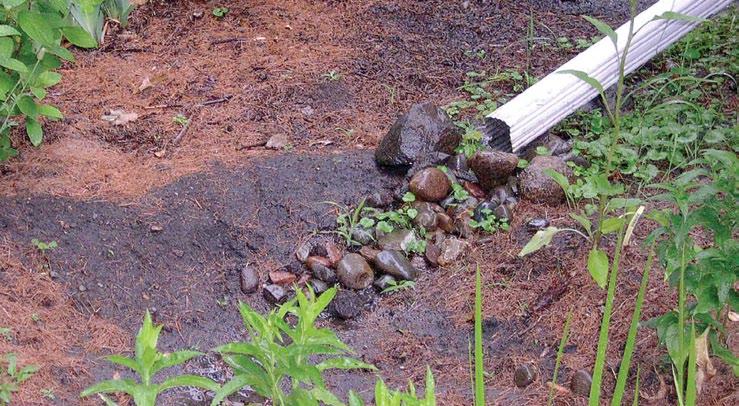 By dorothy dobbie
By dorothy dobbie
Strange as it may seem, people are just beginning to return to the understanding of what plants can do to mitigate water problems. Properly used, plants can cure a multitude of drainage issues that would cost big dollars to fix artificially. Not only can they reduce flooding, they can clean up ground water and absorb contaminants at the same time. By incorporating a rain garden into your property, you can effectively reduce stormwater runoff, prevent soil erosion, and provide a habitat for beneficial wildlife.

First, take a look at your property. Is there a spot where rainwater collects but generally drains away in 24 hours or so? This is an indication of where you should be thinking of creating this special little garden. Alternatively, is there somewhere that receives direct rainfall runoff, such as near downspouts, driveways or sloping areas? The spot you choose should have good drainage and be at least 10 feet from your foundation.
If you live where there is a lot of clay, dig down a foot or so and fill the excavation with soil amended for good drainage, being sure to slope the base away from the house so that the water can overflow away in case of a hard rain. The best mix would be 40 percent sand to 30 percent topsoil and 30 percent compost. You are trying to create a sandy, loamy or even a rocky base for the water to slowly drain but also so that plants can sink their roots down deep in the garden.
This is a great spot to direct the downspout from your roof. You could build a little channel or use a buried
https://www.youtube.com/watch?v=YdBoO3EMBDQ


PVC pipe from the downspout to empty into the rain garden.
Are you wondering if the water garden might breed mosquitoes? It is unlikely. The water should drain away
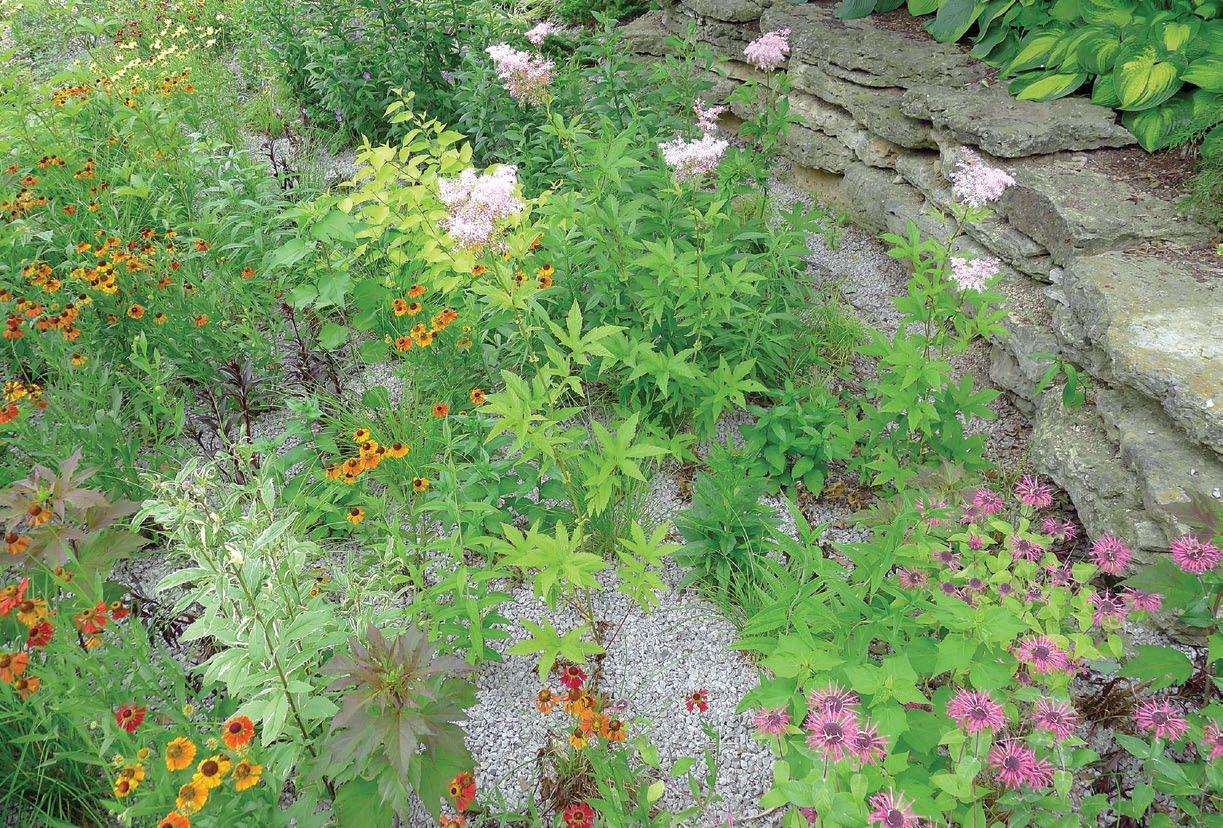

in a day and mosquito eggs need at least five days in stagnant water to hatch.
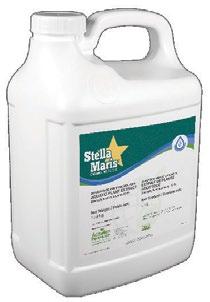
The fun part is what to plant in the rain garden. You need plants with deep roots that can handle being water-soaked for a day or two. Prairie wildflowers are good at these things because they live in a place where there is often drought followed by
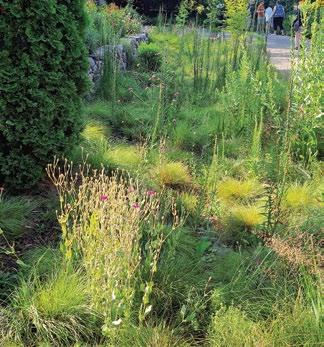
deluge. A good prairie downpour can empty 5 inches of rain on a garden in no time.
Joe Pye weed is a great candidate and so is monarch-loving swamp milkweed. Plant sedges and foxgloves, astilbes and asters where it is deepest, then add coneflowers, sedums and artemisia to the margins. False sunflower and monarda are also mois-
ture lovers that can handle drought.




As a final touch, edge the garden with field stone to secure the edges and to provide a natural look. Butterflies, dragonflies, birds and bees are all going to be frequent visitors.
Perhaps set a bench overlooking this miniature paradise where you can dream away the hours to the sound of nature. P
1. Stormwater management. Rain gardens effectively reduce stormwater runoff by capturing and infiltrating rainwater. This helps prevent erosion, reduces the burden on stormwater systems, and minimizes the risk of localized flooding.

2. Water quality improvement. As water infiltrates through the soil and plant roots, it undergoes natural filtration, which removes pollutants, sediments, and nutrients. This helps protect nearby water bodies from contamination and improves overall water quality.
3. Groundwater recharge. By allowing rainwater to infiltrate into
the ground, rain gardens contribute to the recharge of groundwater, which helps maintain healthy aquifers and sustains the water supply.
4. Habitat creation. The use of native plants in rain gardens provides valuable habitat for pollinators, birds, and other beneficial wildlife, promoting biodiversity and ecological balance.
5. Aesthetics. Rain gardens add beauty and visual interest to landscapes, enhancing curb appeal and potentially increasing property values. They can be designed to complement the overall garden design and create a peaceful, natural setting.

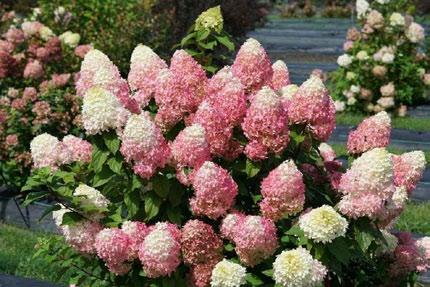
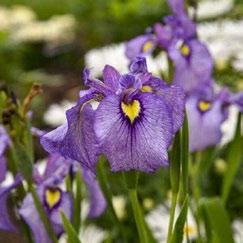
The concept of rain gardens can be traced back to ancient times, where civilizations implemented various techniques to manage rainwater. The current practice of rain gardening emerged in the late 20th century as a response to urban stormwater runoff issues and the need for sustainable water management solutions.
Throughout history, civilizations across the world have employed various methods to manage rainwater. Examples include the ancient Mayans’ use of reservoirs and canals, the Aztec chinampa farming in lakes, the Persian Qanat systems, and traditional Japanese gardens incorporating rainwater collection and irrigation techniques.
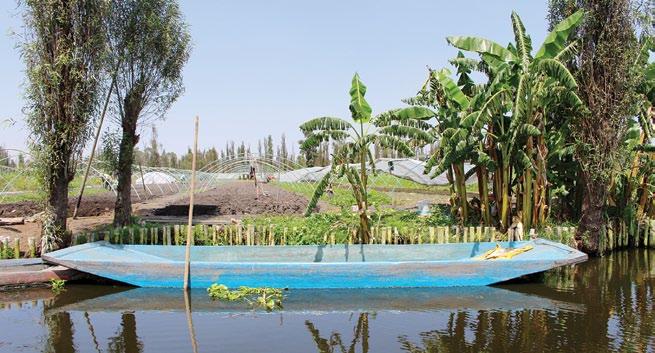
With urbanization and the increase in impervious surfaces such as roads, parking lots, and rooftops, stormwater runoff became a significant issue. Traditional methods of channeling runoff into sewers or bodies of water led to flooding, erosion, and water pollution. In the 1980s and 1990s, environ-
mental concerns prompted a shift toward more sustainable stormwater management practices. Professionals in fields such as landscape architecture, civil engineering, and urban planning started developing innovative strategies to capture and treat stormwater on-site.

The concept of rain gardens gained momentum as a practical and aesthetically pleasing way to manage stormwater runoff. Rain gardens are
designed to mimic natural ecosystems, promoting water infiltration, pollutant filtration, and the replenishment of groundwater. Extensive research and demonstration projects have been conducted to refine rain garden design and measure their effectiveness. Organizations, universities, and government agencies play a significant role in promoting rain gardens as a sustainable stormwater management tool.
Is it a garden or a garden centre or both?
Gloria Beck’s Parkland Nursery in Red Deer is an ode to all gardens and to earning a living doing what you love. It reflects her as a leader in her community, in Canada and internationally. Gloria is a past president of the Canadian Nursery and Landscape Association of Canada. She is twice former chair of the International Garden Centres Association and was the first North American woman to hold that position. She was also the co-chair of Canada’s Year of the Garden 2022 Advisory Committee.
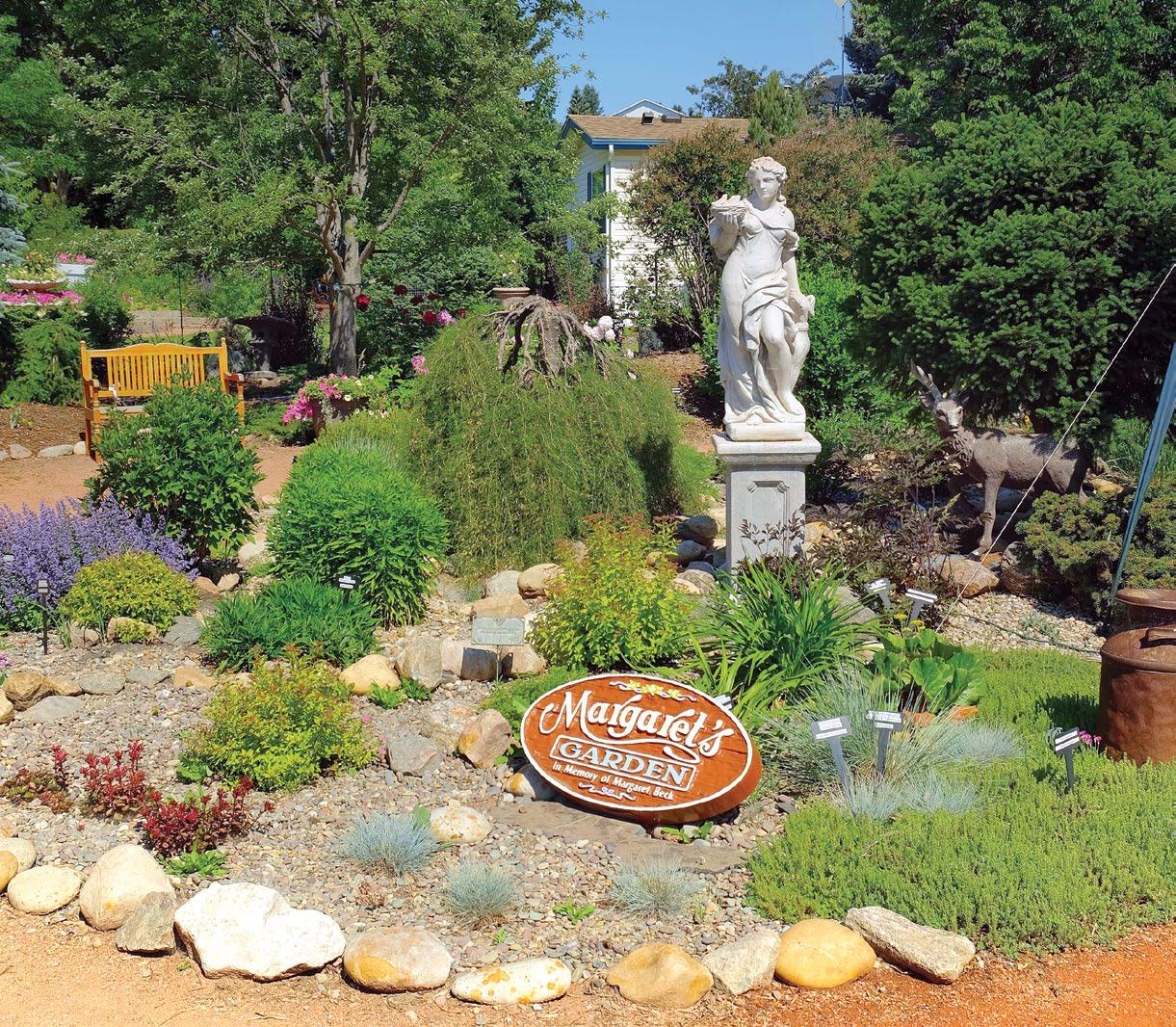
Gloria is a good business operator, but she is also a gardener to the tips of her fingernails. She lives it, breathes it and takes delight in being contagious with it. You cannot be in Gloria’s presence for long without the garden coming out in both of you.
Gloria brought home much of what she learned travelling to and visiting garden centres in Africa, England,
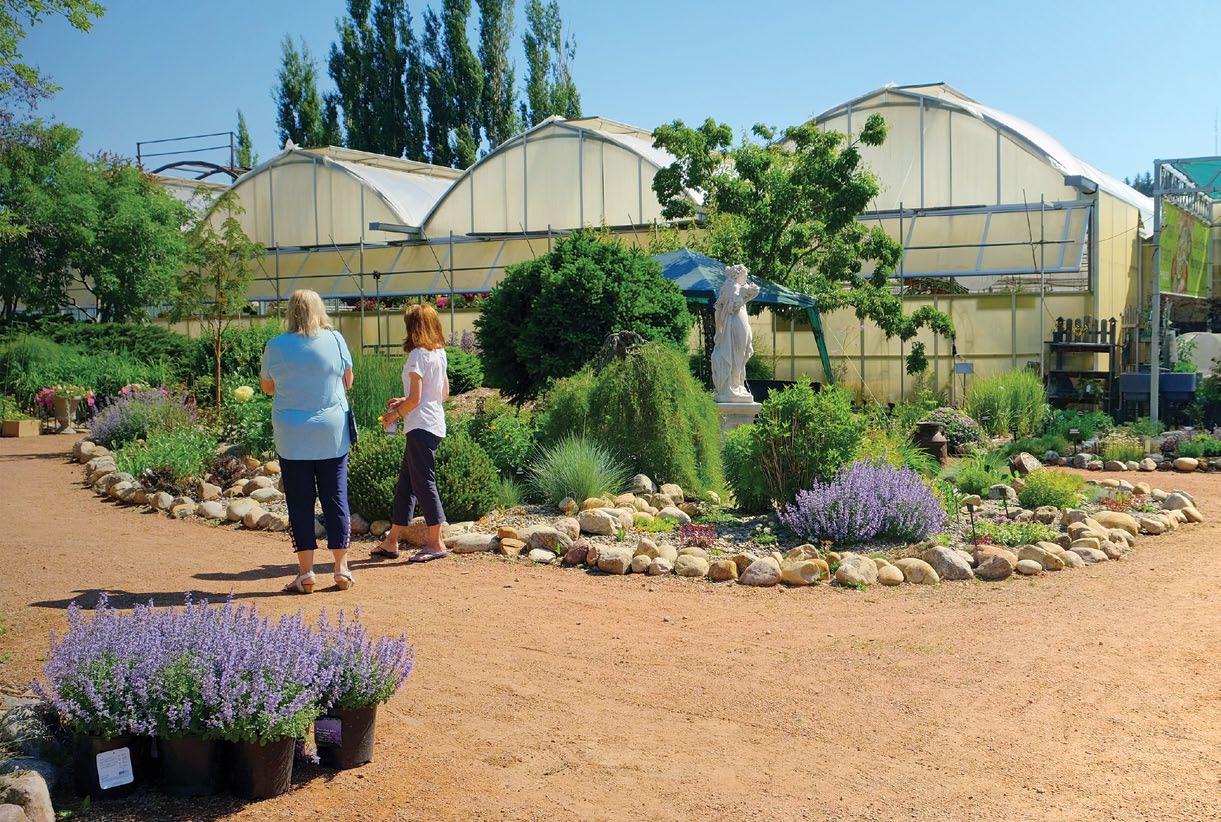
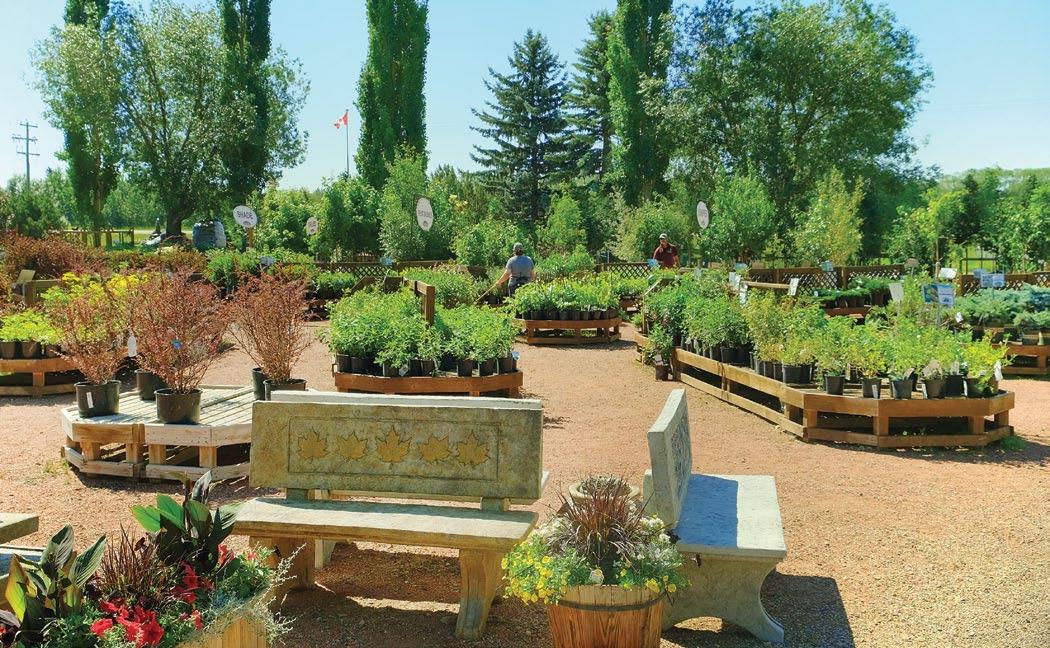
The gazebo at Parkland. It is lilac season in Alberta, and the perfume fills the air with expectation.

California poppies.
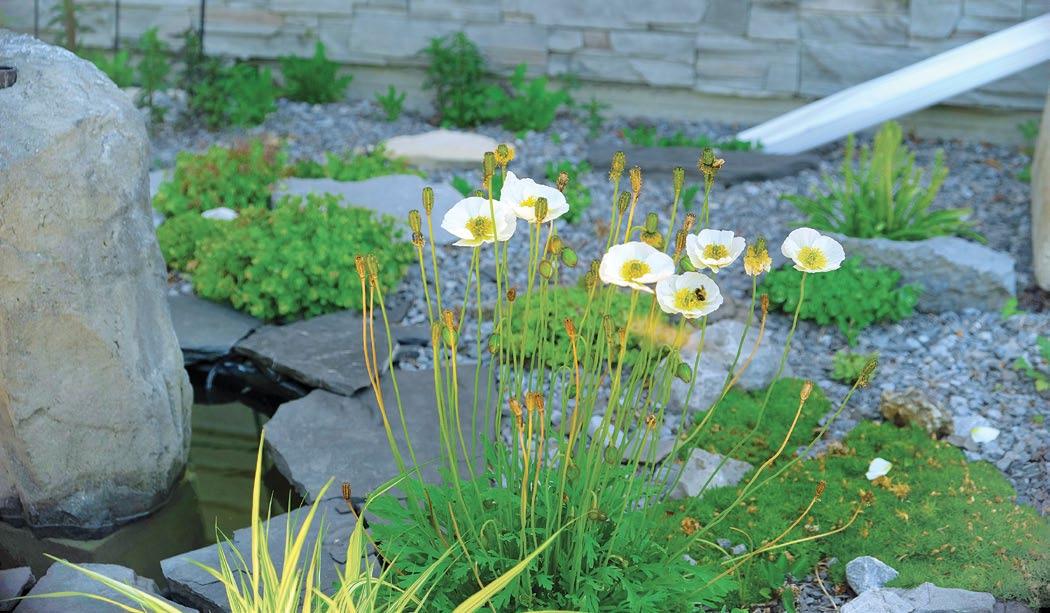
Australia, Ireland, New Zealand, Spain, United States, Holland, Switzerland, and Germany to apply in her own garden centre. When shoppers come to Gloria’s nursery, it is with the understanding that this is an experience, one to be savoured and enjoyed. They come to do more than shop. They can appreciate the plants and plantings, taking a seat on a well-placed garden bench to survey the wonders all around them and simply enjoy the pleasure of feeding their own garden addiction.
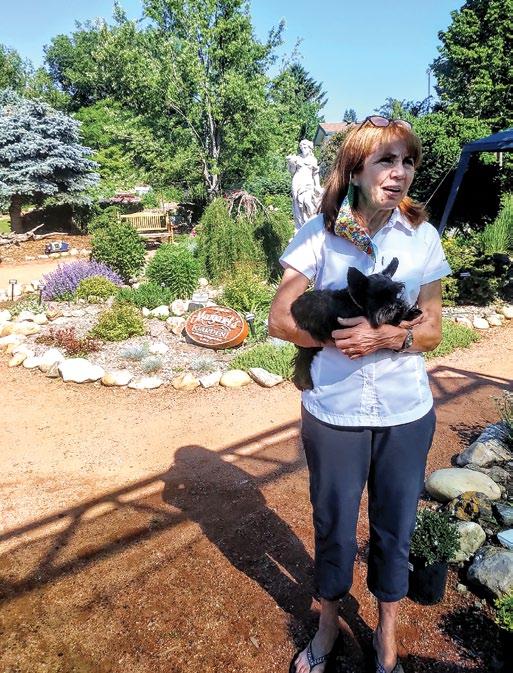

This day in her garden, it is lilac season in Alberta, and the perfume fills the air with expectation. There is nothing quite like a prairie spring with the sudden awakening of plants everywhere bursting with energy and in a hurry to start the season of growth.
Sitting in the garden gazebo at one end of the property, a visitor can view the outdoor garden part of the business spread out in a tapestry of colour and excitement below. The garden centre itself looks like a country house waiting for visitors.
Gloria not only shows you what to buy but how you can use your purchases in little garden vignettes all round. The yellow Itoh peonies are surrounded by lime leafed barberry shrubs in front of a blue spruce to demonstrate their complementary colours. Cartloads of spring plants are set outdoors in perfectly arranged clusters that say, “Buy me!”.
A rock-edged display garden presided over by a marble statue stands in front or the green houses, providing
subtle advice on what and where to plant things. A pair of yellow Adirondack chairs are staged above of a koi pond. California poppies spring from a rock garden surrounding a pool. Pretty white gas plants and yellow sundrops, lupine and other prairie plants are shown to their best advantage. A little rock garden filled with dwarf shrubs and succulents surrounds architectural rock and some prairie “driftwood”, bleached by the sun. A display of planted succulents showcases how diversely beautiful they are.
In the centre of it all there is a special garden, Margaret’s Garden, dedicated to the memory of Gloria’s mother. It is filled with hosta and lamium and several different kinds of lungwort and blue campanula.

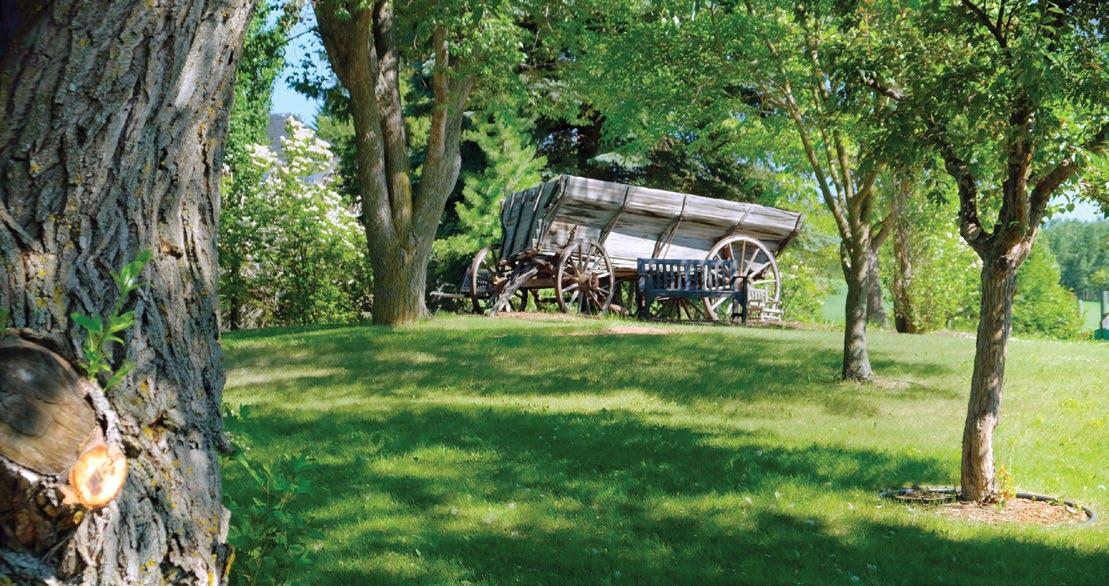
Meanwhile, the queen of every prairie garden, the peony, steals the show wherever it can.
Gloria celebrates every season. Ice sculptures decorate the garden in winter. Christmas is a fantastic display of lights and colour. Indoors, the garden centre offers year-round relief from the colder seasons with a tropical house where happy fish ply the warm waters, and that irresistible smell of the good earth and things growing reminds us that a new season is just around the corner.
It takes a special person to do all that Gloria has done. She is generous and warm which is one more reason her customers love her. She is a pillar of her community and takes pride in the gardens of those she serves.
There is a little piece of Gloria in all their gardens … it is her heart. P
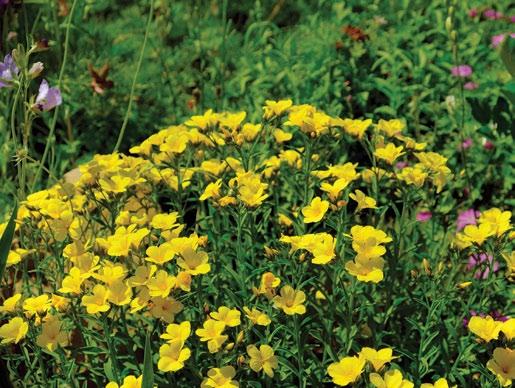
Simply download Canada’s Local Gardener app on your mobile device and you can access the digital editions of the magazine quickly and easily!
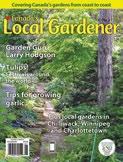
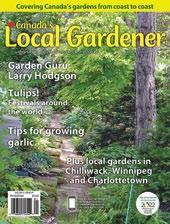


Read, relax, enjoy.



story by dorothy dobbie, photos by dorothy dobbie (except where noted)
It is a smoky early June day in Chelsea, Quebec, probably a little soon to do a garden story but the opportunity is available, so why not? The taxi driver is amenable, not just to the long drive but to waiting while the garden is explored. It is a storied garden say all who know of it.
Farther and farther into the woods we go, getting closer to the outer fringes of Gatineau Park. It feels like the end of the road, yet there it is, a fairy tale house snuggled up against a rock cliff on one side and a pool of water on the other.
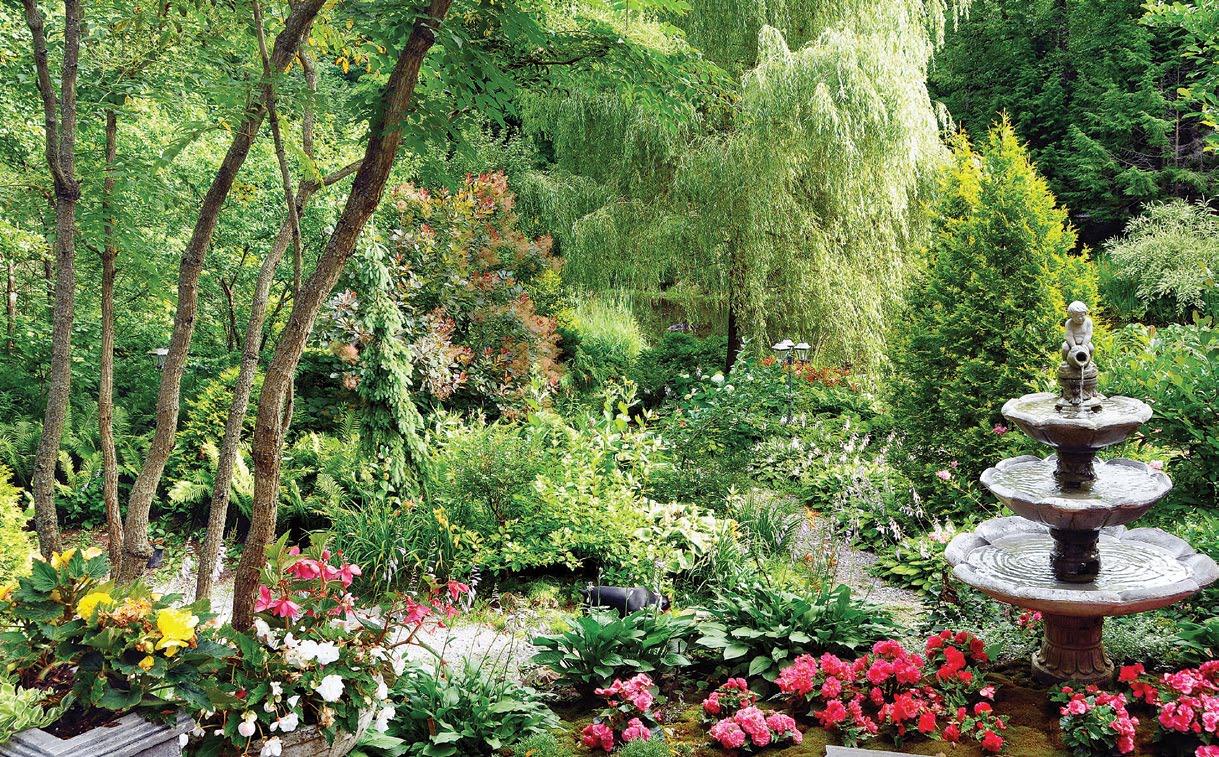
The garden was enlarged, and the immediate over the hills and
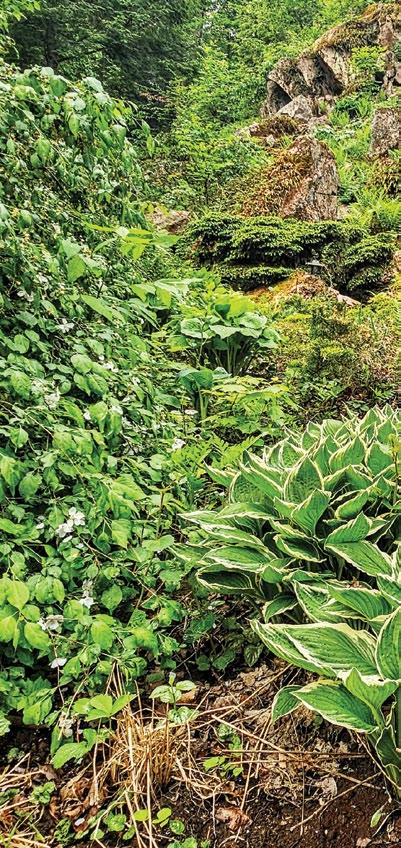
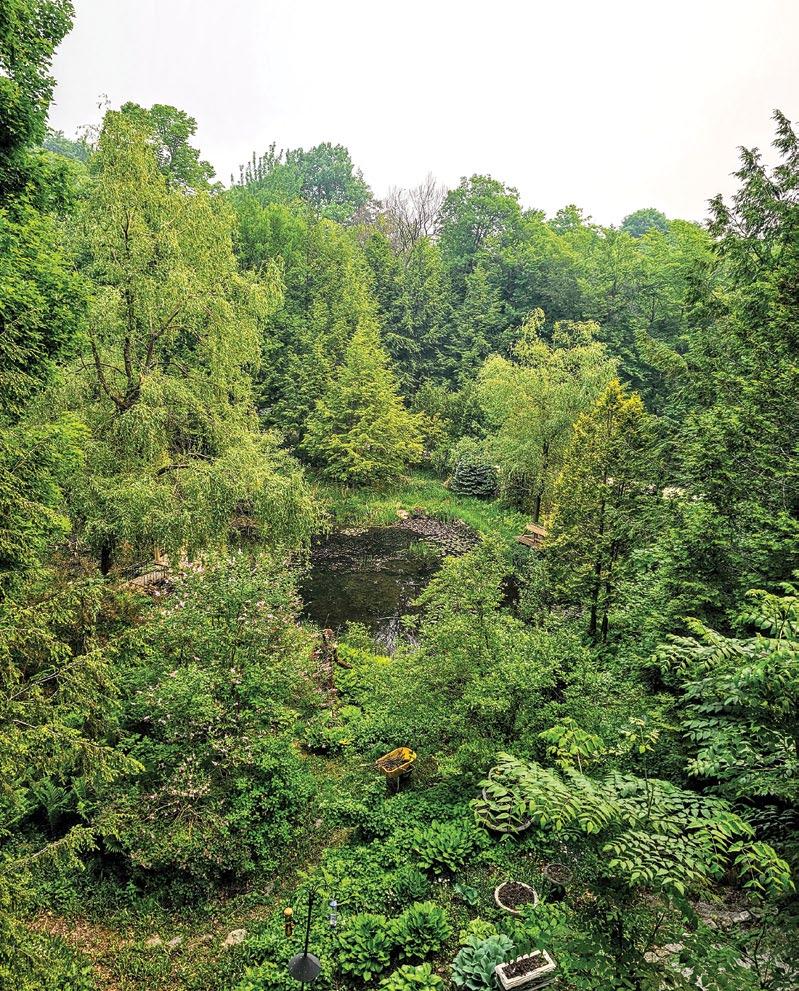

A knock on the door is responded to by a tall thin man who looks like Prince Charming in his light coloured, high collared shirt that matches his curly, graying hair. The house inside is a replica French chateau, very baroque and elegant, everything chosen for its aesthetic appeal. Light pours in from three sides of the large sitting-dining room. There are candelabra everywhere and ornate light sconces. The furniture is deeply comfortable and carefully chosen to project style and sophistication. This is the centre piece to the garden.
The tour begins with the sunroom, illuminated by light shining through stained glass hangings. “I started doing these,” said Adrien Clavet, one half of the team that built this dream world. The other half is Réjean Lyrette, not in evidence yet, but he will be home soon. Adrien points to the stained glass and adds, “Then my sister took it up and she elevated it to art.” The hangings colour the light entering the room.
Adrien is from New Brunswick – Saint-Basile, which is now part of the small city of Edmunston, a French community of around 20,000, bordering on Quebec.
He has three sisters, one of them his twin. One has a passion for gardening just as does Adrien, although, he says, her style is much different from his. He moved to Ottawa as a young man and worked in government for many years. Early in his career, he saw a photograph of Réjean in a friend’s photo album and fell in love with the picture. Being told, “This guy is not your type,” did not deter Adrien. They met soon after and they became a couple. That was 43 years ago.
Together, they built a home in the village of Chelsea, a municipality north of Ottawa. It snuggles up to Gatineau Park. Although they had completed a home and a garden there, they began looking for another challenge, one that would satisfy a long-time desire of Adrien to create something beautiful in harmony with nature. As they were looking, they came across an 11-acre property that dead ended at the park and the dream began.
It started with the landscape. They began to shape it even before building the house, which is tucked between a rock cliff and a dammed-up creek to create a reflecting pond. The house is now the centre piece to



the garden. They designed it so that from inside, you can see the garden from every room and be in communion with its peace and serenity.
Over time, the garden was enlarged, spilling out from the house and the immediate grounds to meander over the hills and into the forest, where unexpected touches were added to emphasize the Midsummer Night’s Dream-like atmosphere of the garden. There were fairy tale touches all around. At one point the garden featured a Sleeping Beauty bed: a blanket of moss bordered by a cascade of birch bark that masqueraded as bed skirts, lay between iron head and foot boards, the perfect place to find Beauty curled up asleep waiting for Prince Adrien to awaken her.

On the water side of the house, the creek was dammed to create a still pool where swans glide, mirrored in the water. A gazebo was built, a lovely spot for romantic midnight suppers or sun dappled breakfasts. During the daytime, everything is very natural in its surroundings, decorated with local ferns and reeds and a bed of Iris pseudacorus. At night, lights illuminate the entire scene in changing colours.
On one side of the pool stands a moss woman, Estelle, named for the gardener who created her. A wooden footbridge in another corner of the pond is disguised in summer by window boxes so filled with bright annuals on either railing, that visitors are fooled into thinking the flowers are floating.
Statuary, stained glass and wrought iron work appear in expected and unexpected places – the iron gate leading to the pond, is an example. It was created and constructed by Adrien, who loves to dabble in welded art, and his friend
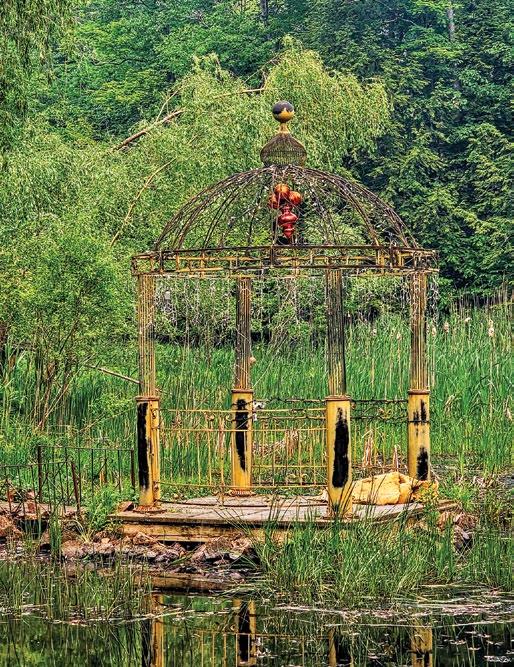
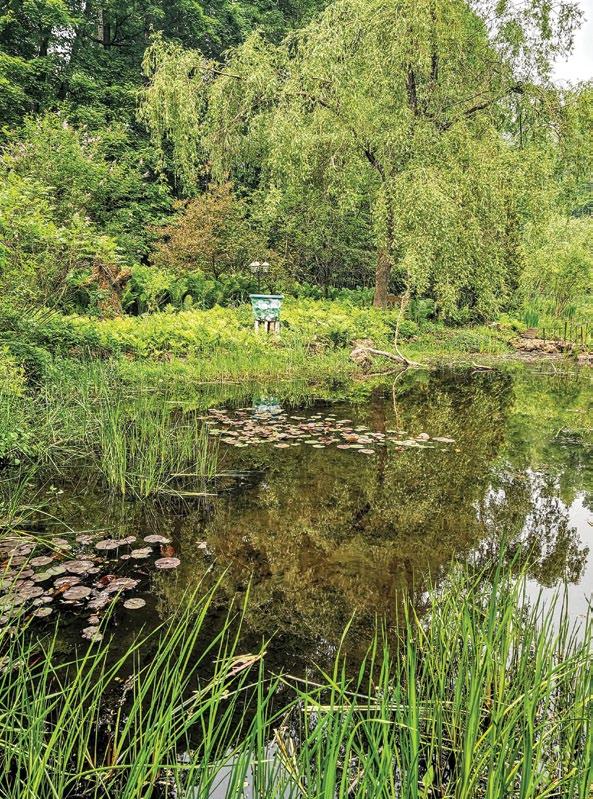
Roger. The gate is decorated by two birds that strut in startling colours. A crow might have red wings, for example. There are whimsical touches everywhere.
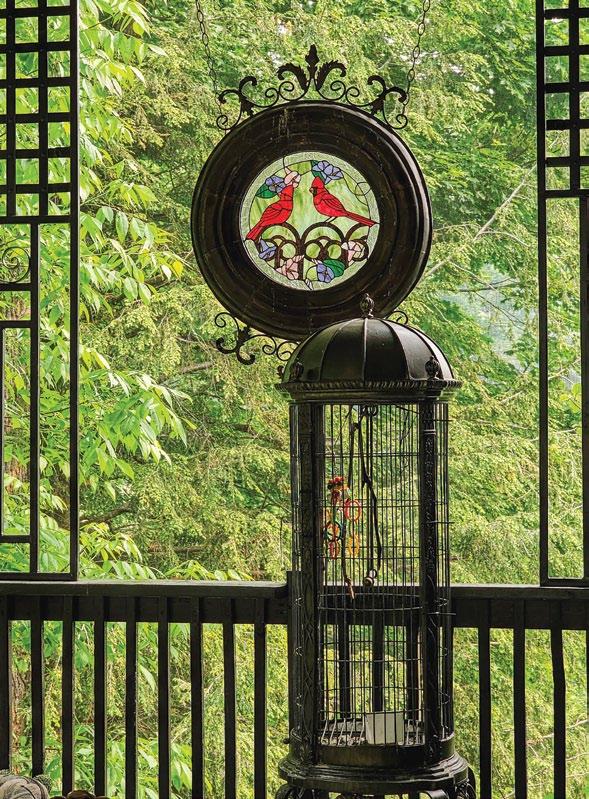
At one time the garden was host to parties attended by beautiful people. The garden was frequently opened to excursions as a local attraction. There are several videos on YouTube featuring the garden and two books produced celebrating it. Many people in Ottawa and Gatineau have visited and know just what you mean when you speak of La Chasse-Gardée du Marais.
Then four years ago, Adrien and Réjean decided to focus on the garden as a place to be nearer to the house. “We have brought the garden closer to us,” he says as he displays the tiny village they are building on the rise near the front driveway just below the chicken coop. Oh, yes, there are chickens. In the emerging village, a replica church and some town buildings are beautifully wrought with all the details. “We have a team working full time on the little village,” says Adrien. He adds, “I have a hard time sleeping because I am filled with the passion of ideas.”
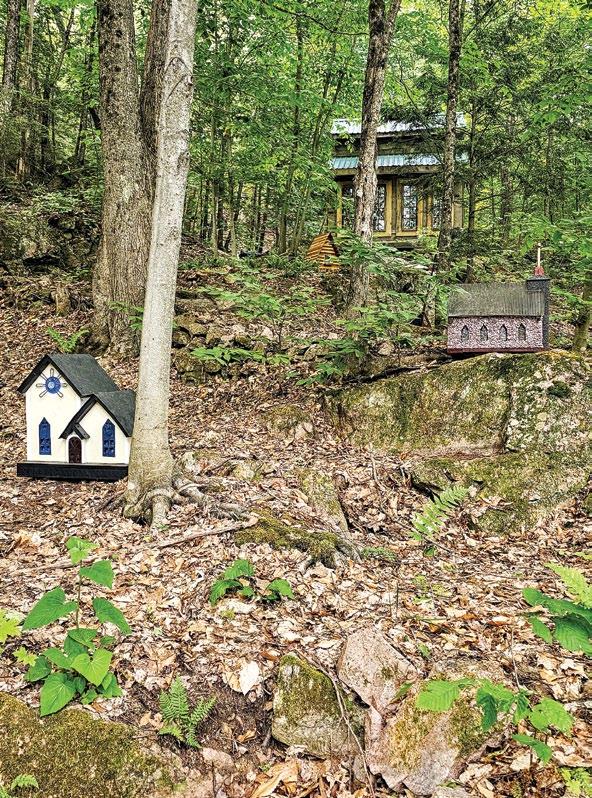
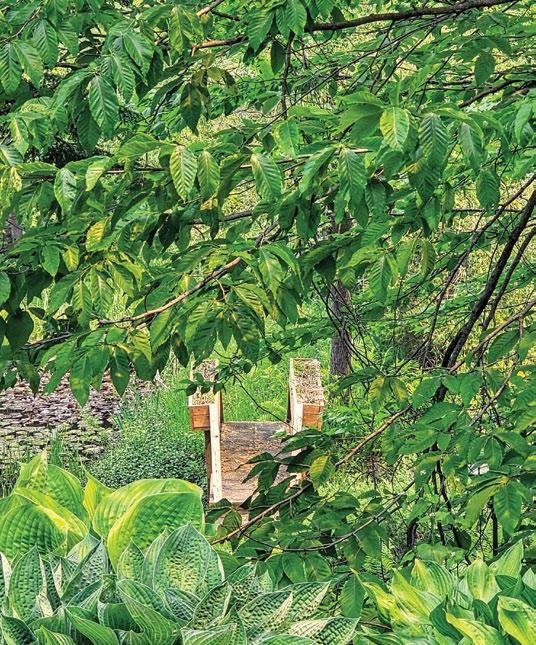
Réjean says little, but you can feel that his comments are in accord with Adrien. They are two side of a coin. “No photos of me, alone,” Adrien instructs. “Only with Réjean. He is half of this garden.”
The smoke has not cleared as we leave, but the taxi driver has visited the garden and his face is full of smiles. He took pictures and sent them to his family. Catching a glimpse of the bridge over the pond, he becomes my collaborator for a moment, backing up so I can snap a photo through the trees. P

story by shauna dobbie, photos by david Johnson
“It helps if you have access to a backhoe,” Gerry says, when talking about putting in their pond. No kidding! The pond area of this garden is a delight hidden by a tall hedge of eastern white cedars all the way around an area of about 50 by 100 feet. Gerry and Judy, who’ve been married 55 years, don’t tell visitors anything about what’s behind the hedge when they visit; they’d rather see your face when you come around the corner. “The biggest thrill I get is the first time somebody sees the pond, then you get that ‘ooh’ and ‘ahh’,” Gerry smiles self deprecatingly here and adds, “That’s a thrill in itself.”

Masterfully executed apparent source of the pond.

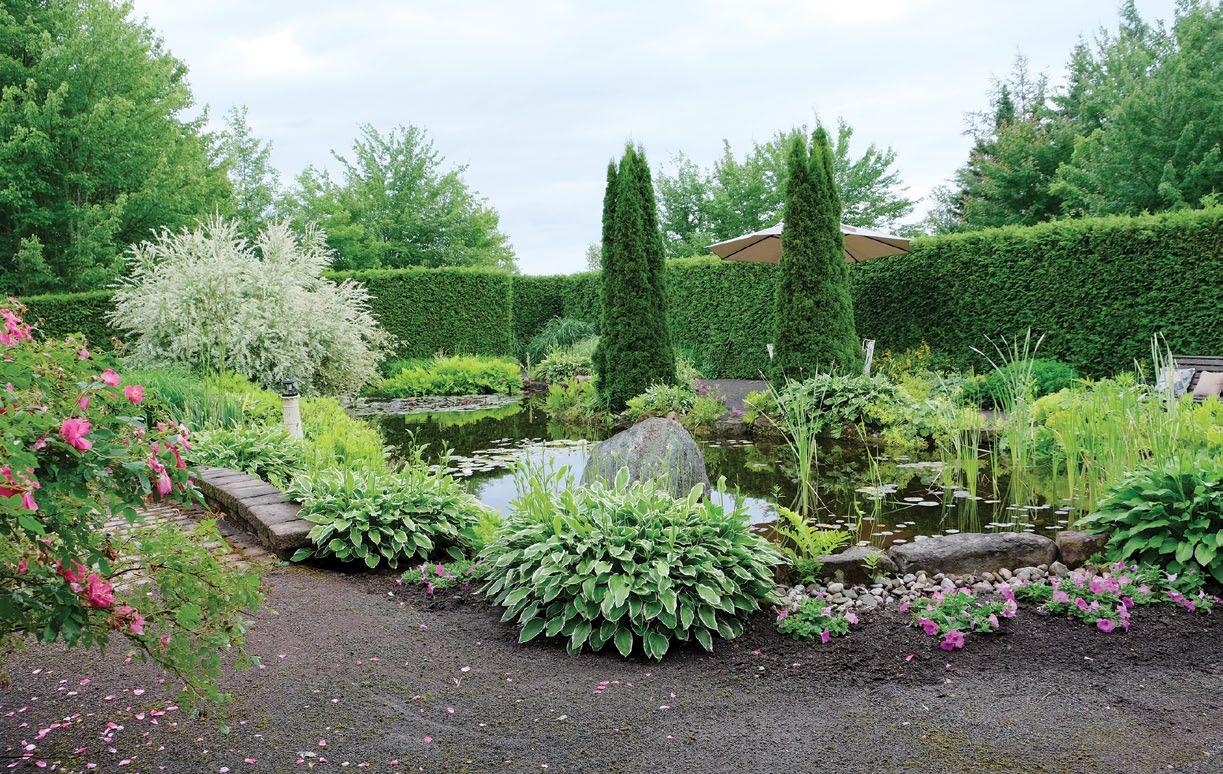

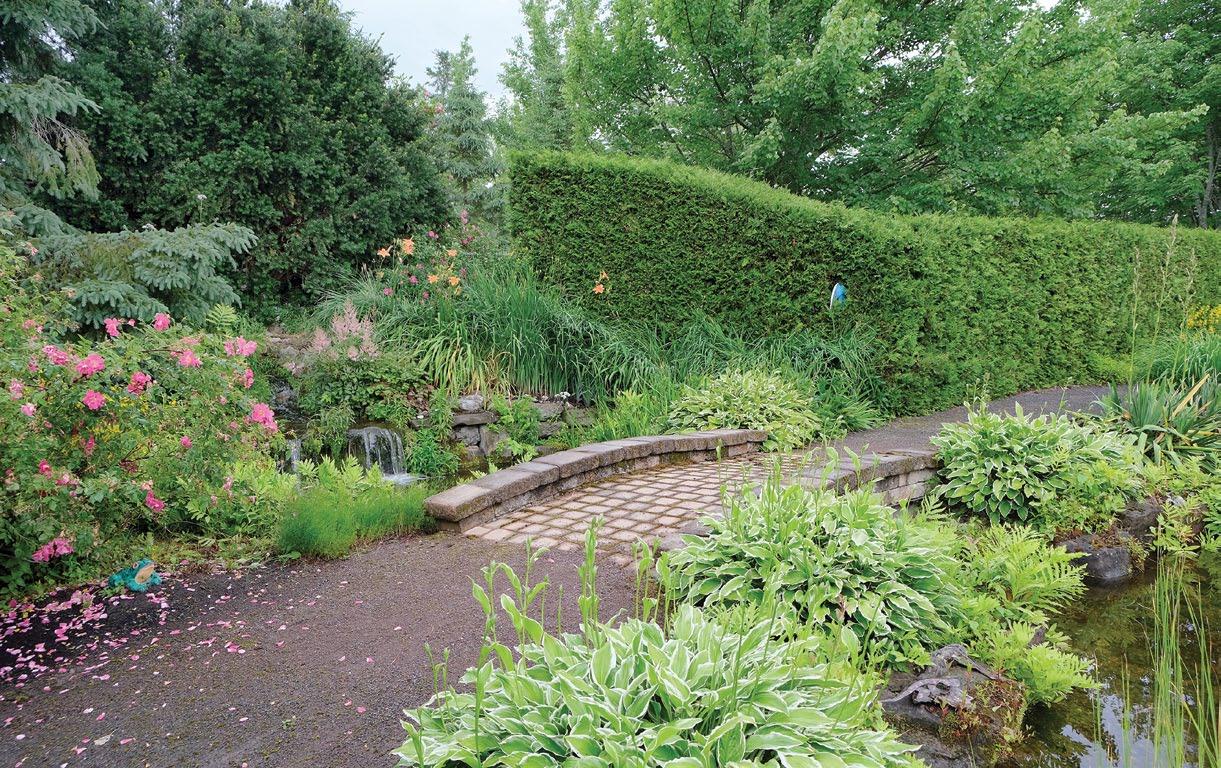
This section of the garden is like the gardens of your imagination: Eden, Xanadu, Shangri-la.
The hedge surrounding the pond is an accomplishment of its own, growing so thick and healthy. He credits an article in Canadian Gardening magazine years ago for telling him how to plant a cedar hedge. He put in about 350 7-inch plugs he bought from a tree farm on Prince Edward Island, following the directions in the magazine exactly. It worked!
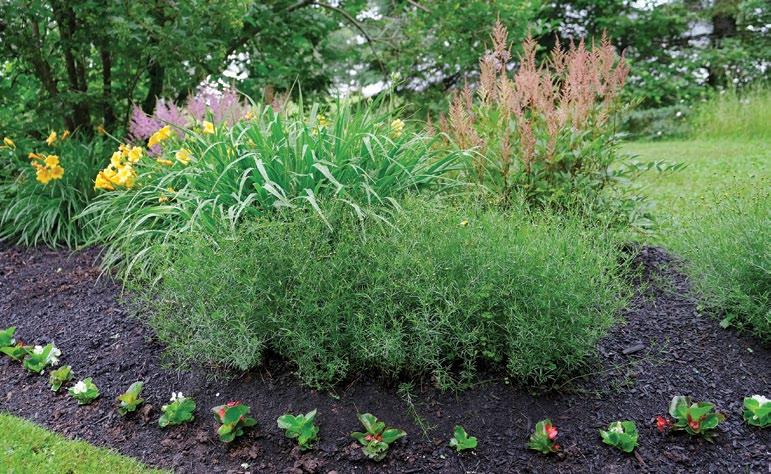
On the inside, this section of the garden is like the gardens of your imagination: Eden, Xanadu, Shangri-la. A crushed-gravel pathway snakes around the central pond, surrounded by plants: hostas, daylilies and Gerry’s beloved yuccas. The path leads you over a stone bridge. The pond is still on one side, and on the other is the apparent source: water spills over rocks so artfully placed it seems it must have been done by nature. Astilbe and yellow loosestrife add colour to a mélange of greens: perennial foliage, trees and damp moss decorate the site.
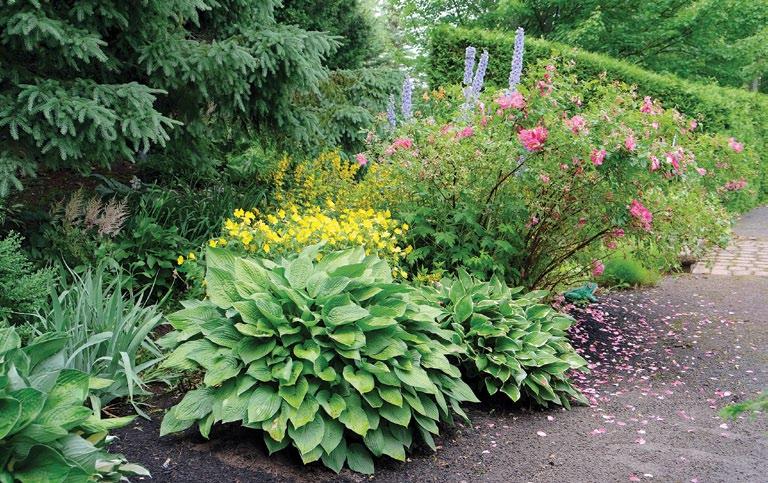
Along one side of the garden is a white wrought-iron patio set and umbrella. What a beautiful place for a meal! It’s the kind of garden you’d love to sit in with a book throughout the day, listening to water running and birds singing, looking up now and again to see if it truly is real.
This is only one part of the couple’s demesne. It is a country property with plenty of area to grow things. There is a sizeable vegetable garden surrounded by square boulders, just starting to grow in tidy rows when we saw it at the beginning of July. The couple’s artfulness cannot be denied in this utilitarian spot, though. A row of marigolds surrounds the plot for insects, and hostas are well grown-in at the corners. At the far side is Gerry’s “petunia tree”. It’s a welded structure he built with three rows of hoops around a pole to support big flowerpots and one on top. Every summer he fills them with petunias; by fall you can’t see the structure at all, the flowers have grown in so well. He included a watering system in the design so the huge planter is good once you have the flowers placed. ‘Wave’ petunias don’t require much deadheading. He only needs to turn on the water for about two minutes and it’s done.
Gerry came to gardening while out for a Sunday drive many years ago. A house in Cornwall was surrounded
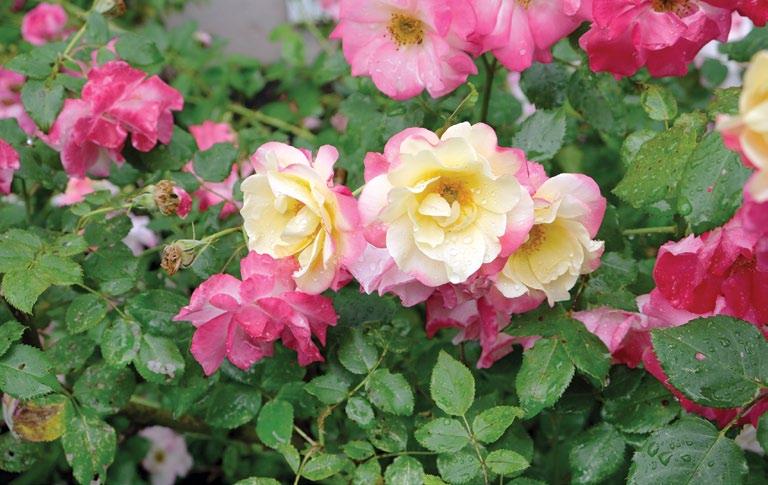
by red and white wax begonias that captured his imagination; he fell in love and vowed to create such a scene someday. That was in the mid-80s and they didn’t settle in their current house until 1996, but the inspiration has lasted. (The couple moved around earlier in their marriage because Gerry was in the Air Force.) Now he and Judy start about 2,500 wax begonias indoors during the winter. They get small plugs from a nursery nearby (they didn’t care for growing from seed) and baby them along under lights until it’s time to plant them in the spring.
Gerry spends about 20 hours per week in the garden, weeding, mowing, edging and trimming. It helps that he’s retired, but he doesn’t head out until after dinner most days. He works in the garden on weekends, too. Judy joins him sometimes, weeding and commenting on where things should go. The two have been members of the Westmorand Horticultural Society – which has been in operation since 1921! – for around 20 years.
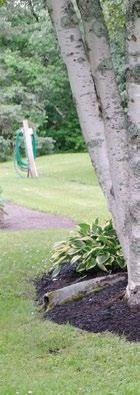
In addition to gardening, he’s an inveterate volunteer, working these days with the Lutz Mountain Heritage Museum. His tireless work earned him a Queen’s Jubilee medal for volunteering a few years ago. Judy urges him to stay home more, to take it easy. After all, he’s earned it. P

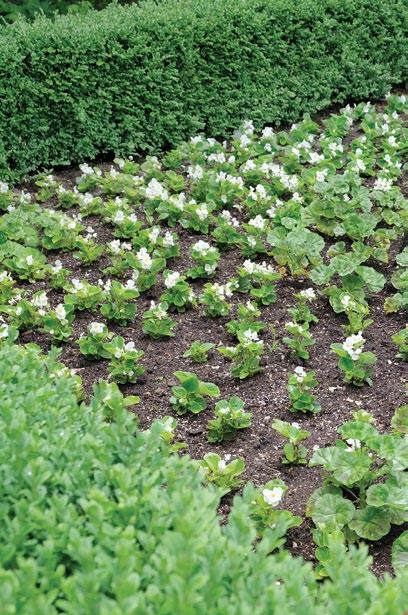

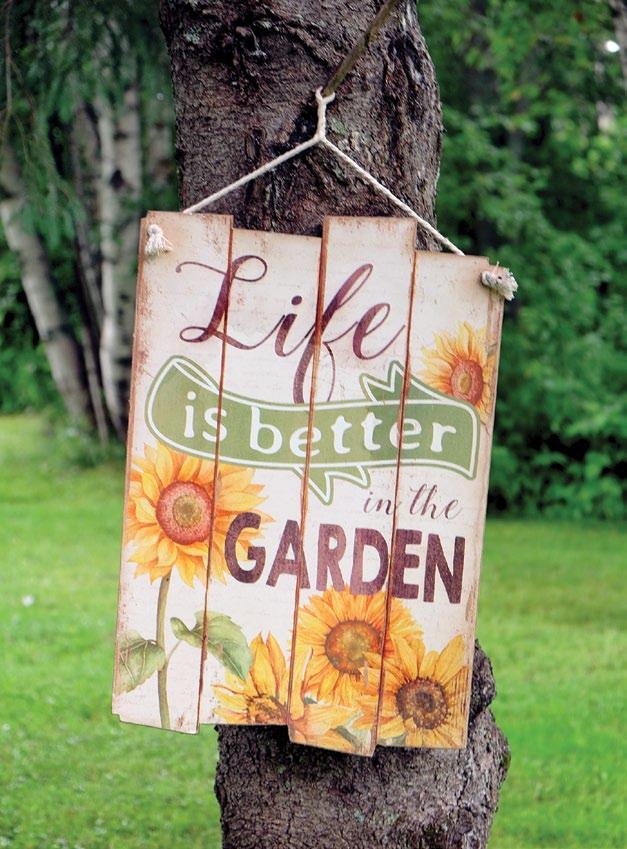
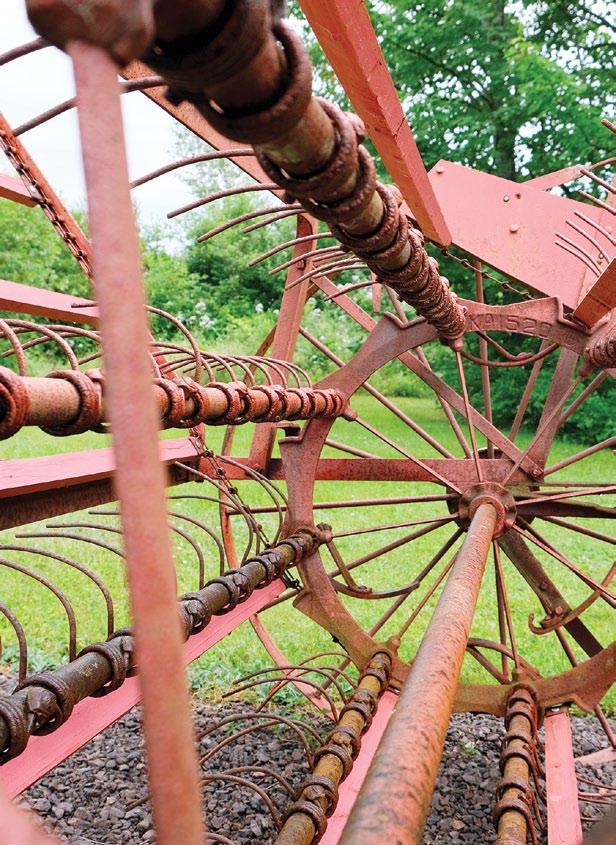

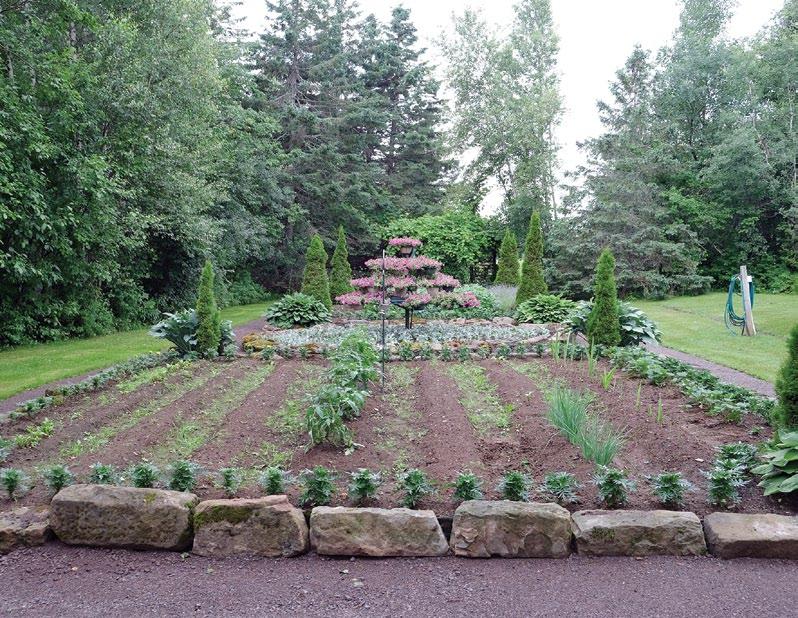



Okay … why didn’t anybody tell me I needed to prune indeterminate tomatoes?
Worse, how could I have written stories about tomatoes without ever realizing that, in full sun with a little room, tomatoes would not just stay compact?
At the end of June, I came back after a short trip away to find my six tomato plants grown into a huge forest. I was impressed. I noticed several green tomatoes on them and waited for them to start to ripen. Then I waited some more, and some more. Finally, I turned to the Internet and found out what to do.

I went at the mass with my garden shears and, over several hours across two weekends, took out two gardenwaste bags of clippings and a mass of green tomatoes. A couple of weeks later? We have so many good-sized ripening and ripened tomatoes that we are not letting anyone leave our house without a bagful.
My cucumbers made it into the ground, two planted around an obelisk. They subsequently sulked at
the indignity of being in an actual garden after having been babied in their Solo cups for so long that there was a fully formed small cucumber on one plant when I put it in the ground. I tied the straggly vines to the obelisk bars, said a little prayer, then left them. They looked pretty sickly for a while, but then they started to produce. How many cucumbers can a middle-aged couple eat? We’ve given away a few with the tomatoes.
The patty-pan squash are new for me, and I put four in the ground on either side of an obelisk-trellis thing. I was afraid the patty-pans might not amount to anything.
They did.
They grew thick and furious. I
peeked under the leaves periodically and would see multiple blossoms. Finally, after pruning the tomatoes, I decided to have a closer look and found several patty-pans the size of softballs. I’ve thinned that out somewhat, and I marvel at how fast these zucchini type things grow. They should be harvested by the time they reach a size of 5 inches across, but they’ll keep growing.
I’ve also harvested some celery, which was not bitter at all, and I’ll use the parsley more now that it is not covered by the tomatoes. My sweet potatoes have started to really take off now, the vines cascading over the sides of the soft raised bed I put them in. (An Amazon purchase; a
big round non-woven container. It worked alright, but it isn’t beautiful.) I’m kind of worried about the cold spell we had this summer and whether the sweets will put on any bulk underground before the frost comes. If they don’t, I’ll try again next year. I didn’t plant them early enough this year, which is a shame because we had such a warm spring.
And my potatoes … oh, my potatoes! They have positively taken over where they’re planted, running into the rhubarb and into the tomatoes. Could they be all top and no bottom?
I’ve planted potatoes before in Toronto, where they competed for sun and root space with a big yew tree. We would get a few potatoes from plant-


My Vegepod. The lettuce was good, but it’s time to retire it. ing about four or six, but just enough for one meal for the two of us. This year, if there’s much there, I’ll have to cure them for storage – a whole new experience.
In my Vegepod, I planted lettuce early in the season. After about three weeks with nothing showing, I figured it must be too hot for lettuce so I planted carrots. Well, now we

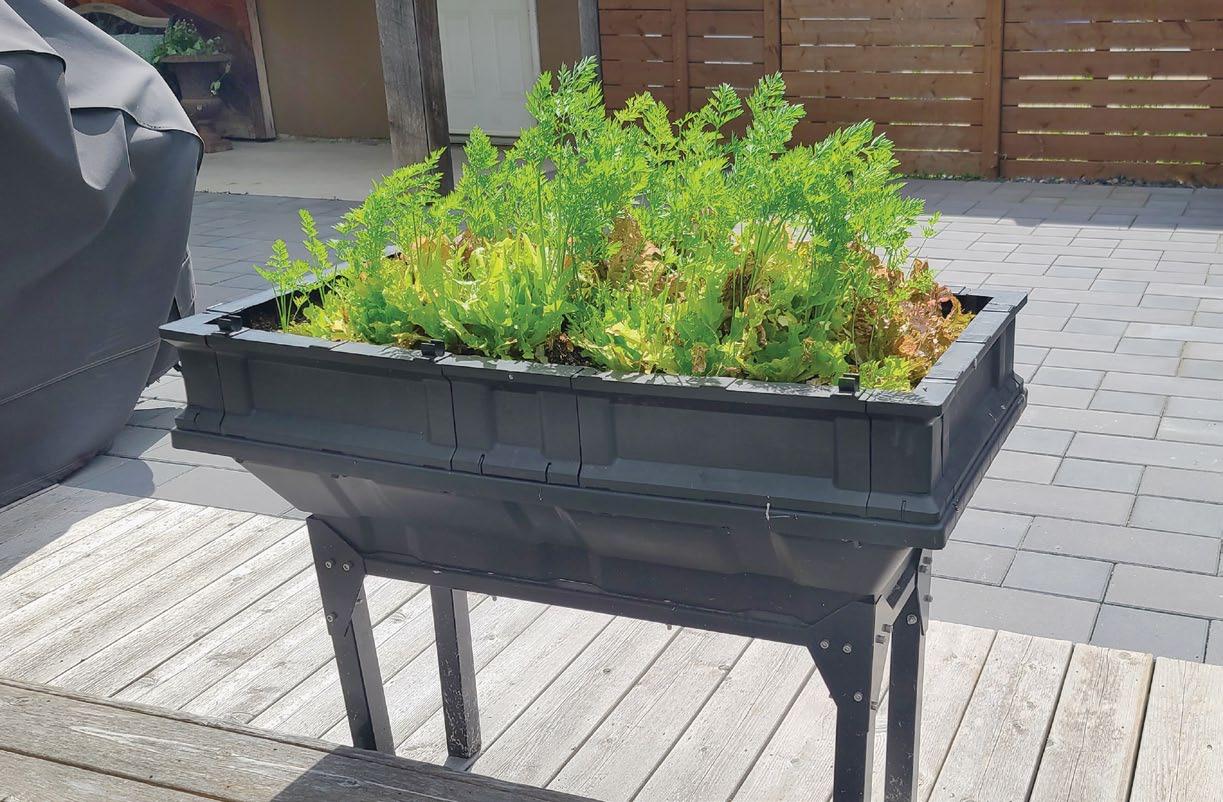
have both growing in the Vegepod. The lettuce have done us quite well and we’ve enjoyed a few salads, but the carrots seem crowded out by them. I couldn’t resist any longer and gave one a tug last week to see how far they’d come. Hmph. It was a skinny little thing, maybe an inch long. This will probably be another year without much in the way of carrots. Next
year I’ll devote a chunk of the veggie garden and my time to making carrots grow.
For fruit, I put in two rhubarbs, about 10 strawberries and two haskap bushes. We haven’t touched them, leaving them to grow strong roots for the future. I’ve pulled off the flowers on the strawberries as soon as they bloom and the runners are running well, putting down new roots and making new plants. The rhubarb is doing what rhubarb does. The haskaps, however, aren’t really doing much except staying alive. This is no easy feat with monster tomatoes and potatoes as neighbours, but I’m hopeful they’re growing underground this year. It’ll be a couple of years before we get any fruit from them.
There is a small cherry tree out front that came with the house, at the corner of the veranda. I put a zip-up bag net over it while the cherries were small and green, though I didn’t hold out much hope for fruit. The tree is not in good shape. One part of it is dead and other parts of it are dripping sap. But we got about 6 pounds of sour cherries from it, which are now
This cherry tree is not in good shape. pitted and in our freezer, waiting to become pies. I think we should plant another cherry tree next year.
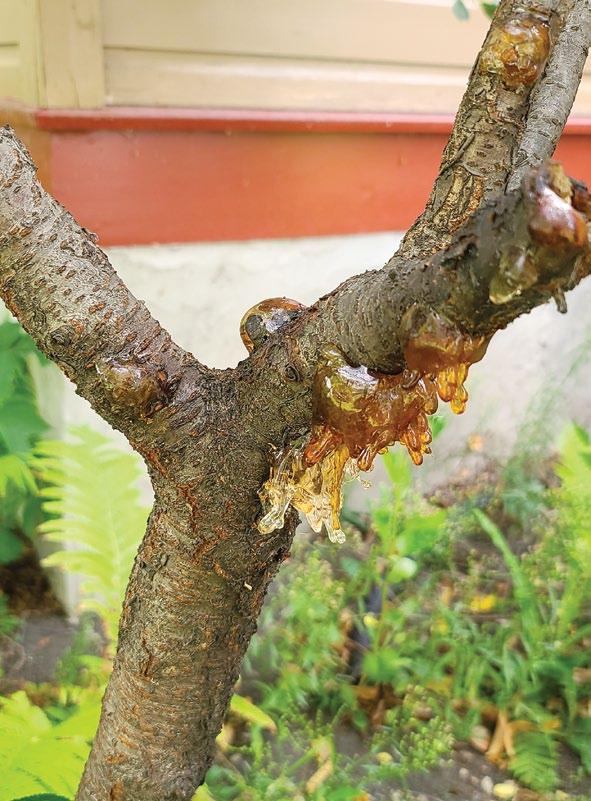
Along the back lane, behind the fence, is where the previous owners planted three saskatoons, which I discovered when they bloomed in the spring. (Saskatoons are known as service berries and June berries in other parts of Canada.) I had thought they were rangy willows until they got the pretty white flowers in April or May. I cleared the weeds around one of them, the one in the sunniest spot, and put netting over it to protect it from the birds. (We have quite the flutter of sparrows in our yard, many of which nest in the purple martin house. I have not seen any purple martins.)

I bought the netting from Amazon, a big roll of it. I should have used a step stool and asked my husband to help me put it up. The saskatoon is about 8 feet high, and I did manage to get it covered, but while doing so a curious sparrow got stuck on the wrong side of the net. The fine nylon strands got tangled around its neck and feet. I cut it out. After that, when
we were away, another sparrow got stuck and died. That seemed to keep the rest of the birds away, and I’ve resolved to use a softer net next year that doesn’t tangle.
We harvested a good 15 pounds of
fruit from that one tree this year, and I have baked my first saskatoon pies. In fact, I’ve tasted my first saskatoon pies and they are simply marvelous! There is a hint of sweet almond in every bite. So good! P
A Collection of Culinary Memories, a new cookbook from our resident foodie Ian Leatt featuring 196 pages of nostalgia-fueled recipes is coming soon!

Pre-order a tasty copy for yourself at a special reduced price of only
$25.00 for a limited time only! Plus taxes and shipping.
Call Erica at 1-888-680-2008 to reserve your copy!
Sponsors:


• A severe case of West Nile virus (WNV) can be life-threatening and may result in long-term disability.
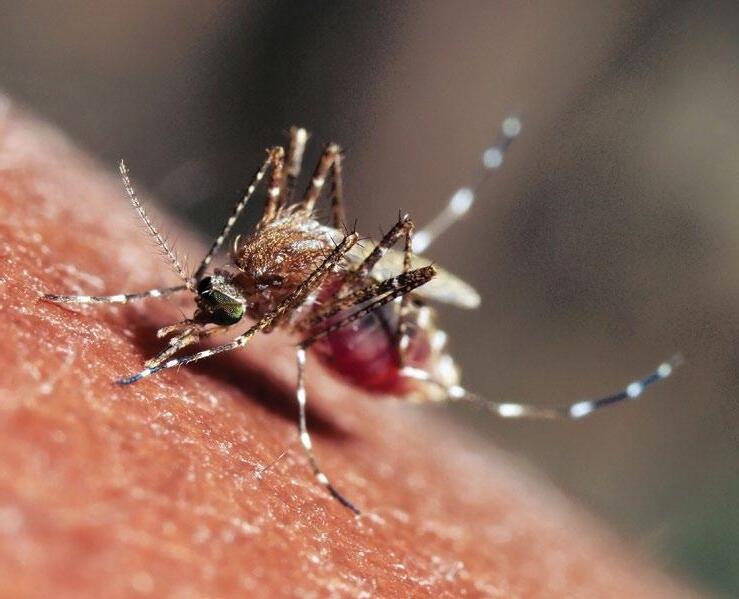
• Some people develop an illness with symptoms such as fever, rash, headache, fatigue and body aches.
• Most people infected with WNV have no symptoms and do not become ill.
• Everyone is at risk of coming into contact with the virus.
• Severe illness most often occurs among older adults or people with chronic health conditions or weakened immune systems. However, severe illness has occurred in all age groups.
• The risk of WNV infection is highest during late June, July, August and early September.
• The risk varies from year to year based on temperature, precipitation, mosquito population and other factors.
• Reduce the time you spend outside between dusk and dawn.
• Apply an appropriate mosquito repellent.
• Wear light-coloured, loose-fitting clothing with long sleeves and pant legs.
• Get rid of standing water around your home.
• Make sure your door and window screens fit tightly and are free of holes.
For more information, visit our website at manitoba.ca/health/wnv. For questions about WNV health concerns, contact your doctor or call Health Links – Info Santé at 204-788-8200 (in Winnipeg); toll-free 1-888-315-9257.